Kenmore Elite 79575077910, 79575075910, 79575067910, 79575065910, 79574407910 Owner’s Manual
...
Use & Care Guide
Manual de Uso y Cuidado
Kenmore Elite®
Bottom Freezer Refrigerator
Congelador Inferior Refrigerador
Model/Modelo: 795.7507# - PreView Grab-N-GoTM Model/Modelo: 795.7506# - Standard Door Model/Modelo: 795.7440# - Standard Door
# = color number, número de color
MFL69497030_Rev.00
Transform SR Brands Management LLC
Hoffman Estates, IL 60179 U.S.A.
www.kenmore.com

TABLE OF CONTENTS
Warranty.............................................................. |
3 |
Product Record................................................... |
4 |
Important Safety Instructions ..................... |
5-7 |
Electrical & Grounding Requirements .......... |
7 |
Parts and Features ....................................... |
8-9 |
Refrigerator Installation ............................ |
10-18 |
Unpacking Your Refrigerator ....................... |
10 |
Installation ....................................................... |
11 |
Removing/Replacing Your Refrigerator and |
|
Freezer Handles, Doors and Drawers.... |
12-17 |
Leveling and Door Alignment ...................... |
18 |
Using Your Refrigerator ............................. |
19-33 |
Setting the Controls.................................. |
19-20 |
Smart Features............................................... |
21 |
Instructions for Smart Grid........................... |
22 |
FCC Notice .................................................... |
23 |
In-Door Ice Bin............................................... |
24 |
In-Door Icemaker.................................... |
25-26 |
Freezer Icemaker..................................... |
25-26 |
Food Storage Guide ................................... |
27 |
►►Refrigerator Section |
|
Water Dispenser .......................................... |
28 |
Refrigerator Shelves ..................................... |
29 |
Humidity Controlled Crisper........................ |
30 |
Temperature Controlled Pantry Drawer...... |
30 |
Door Bin ......................................................... |
30 |
PreView Grab-N-Go ..................................... |
31 |
Grab-N-Go Case .......................................... |
31 |
Replacing the Air Filter................................ |
32 |
►►Freezer Section |
|
Freezer Ice Bin .............................................. |
32 |
Pullout Drawer .............................................. |
33 |
Durabase ....................................................... |
33 |
Durabase Divider ......................................... |
33 |
Water Filter ................................................. |
34-37 |
Care and Cleaning .................................... |
38-39 |
General Cleaning Tips ................................ |
38 |
Exterior .......................................................... |
38 |
Inside Walls .................................................. |
38 |
Door Liner and Gaskets .............................. |
38 |
Plastic Parts.................................................... |
38 |
Condenser Coils ........................................... |
38 |
Light Bulb Replacement .............................. |
39 |
Power Interruptions ...................................... |
39 |
When You Go On Vacation ....................... |
39 |
When You Move .......................................... |
39 |
Connecting the Water Line....................... |
40-42 |
Troubleshooting Guide ............................. |
43-50 |
Service .............................................. |
Back Cover |
2

Warranty
REFRIGERATOR WARRANTY
KENMORE ELITE LIMITED WARRANTY
WITH PROOF OF SALE, the following warranty coverage applies when this appliance is correctly installed, operated and maintained according to all supplied instructions.
One Year on Appliance
FOR ONE YEAR from the date of sale this appliance is warranted against defects in material or workmanship. A defective appliance will receive free repair or replacement at option of seller. This warranty coverage applies for only 90 days from the sale date if the appliance is ever used for other than private household purposes.
Five Years on Sealed Refrigerant System
FOR FIVE YEARS from the date of sale, the sealed refrigerant system of this appliance is warranted against defects in material or workmanship.*
If a system part is defective within the first year, a new part will be supplied and installed at no charge. If a system part is defective after the first year, a new part will be supplied but not installed at no charge. You are responsible for the labor cost of part installation after the first year from the date of sale. This warranty coverage applies for only one year from the sale date if the appliance is ever used for other than private household purposes. *Defects must be verified by a Sears authorized service representative.
Ten Years on Linear Compressor
FOR TEN YEARS from the date of sale, the linear compressor of this appliance is warranted against defects in material or workmanship.* If the compressor is defective within the first year, a new one will be supplied and installed at no charge. If the compressor is defective after the first year, a new one will be supplied but not installed at no charge. You are responsible for the labor cost of part installation after the first year from the date of sale. This warranty coverage applies for only two years from the sale date if the appliance is ever used for other than private household purposes. *Defects must be verified by a Sears authorized service representative.
Lifetime on Storage Bins
FOR AS LONG AS IT IS USED from the date of sale, a free replacement will be supplied for a defective refrigerator or freezer compartment storage bin.* If the defect appears within the first year, a new bin will be installed at no charge. If the defect appears after the first year, a new bin will be supplied but not installed at no charge. This Lifetime warranty covers only storage bins, and does not apply to any other related component or mechanism. You are responsible for the labor cost of bin installation after the first year from the date of sale. This warranty coverage applies for only 90 days from the date of sale if the appliance is ever used for other than private household purposes. *Warranty coverage applies to door bins, drawer bins and basket bins. Defects must be verified by a Sears authorized service representative.
For warranty coverage details to obtain free repair or replacement, visit the web page: www.kenmore.com/warranty
This warranty covers ONLY defects in material and workmanship, and will NOT pay for:
1.Expendable items that can wear out from normal use, including but not limited to filters, belts, bags or screw-in base light bulbs.
2.A service technician to clean or maintain this appliance, or to instruct the user in correct appliance installation, operation and maintenance.
3.Service calls to correct appliance installation not performed by Sears authorized service agents, or to repair problems with house fuses, circuit breakers, house wiring, and plumbing or gas supply systems resulting from such installation.
4.Damage to or failure of this appliance resulting from installation not performed by Sears authorized service agents, including installation that was not in accord with electrical, gas or plumbing codes.
5.Damage to or failure of this appliance, including discoloration or surface rust, if it is not correctly operated and maintained according to all supplied instructions.
6.Damage to or failure of this appliance, including discoloration or surface rust, resulting from accident, alteration, abuse, misuse or use for other than its intended purpose.
7.Damage to or failure of this appliance, including discoloration or surface rust, caused by the use of detergents, cleaners, chemicals or utensils other than those recommended in all instructions supplied with the product.
8.Damage to or failure of parts or systems resulting from unauthorized modifications made to this appliance.
9.Service to an appliance if the model and serial plate is missing, altered, or cannot easily be determined to have the appropriate certification logo.
Disclaimer of implied warranties; limitation of remedies
Customer’s sole and exclusive remedy under this limited warranty shall be product repair or replacement as provided herein. Implied warranties, including warranties of merchantability or fitness for a particular purpose, are limited to one year on the appliance, five years on the sealed system, and ten years on the linear compressor, or the shortest period allowed by law. Seller shall not be liable for incidental or consequential damages. Some states and provinces do not allow the exclusion or limitation of incidental or consequential damages, or limitation on the duration of implied warranties of merchantability or fitness, so these exclusions or limitations may not apply to you.
This warranty applies only while this appliance is used in the United States.
This warranty gives you specific legal rights, and you may also have other rights which vary from state to state.
Transform SR Brands Management LLC, Hoffman Estates, IL 60179
3

Product Record
In the space below, record the date of purchase, model and serial number of your product. You will find the model and serial number printed on an identification label located on the interior liner of the refrigerator compartment. Have these items of information available whenever you contact Sears concerning your product.
Model No.___________________ |
Date of Purchase ___________________ |
Serial No.____________________ |
|
Save these instructions and attach your sales receipt for future reference.
4
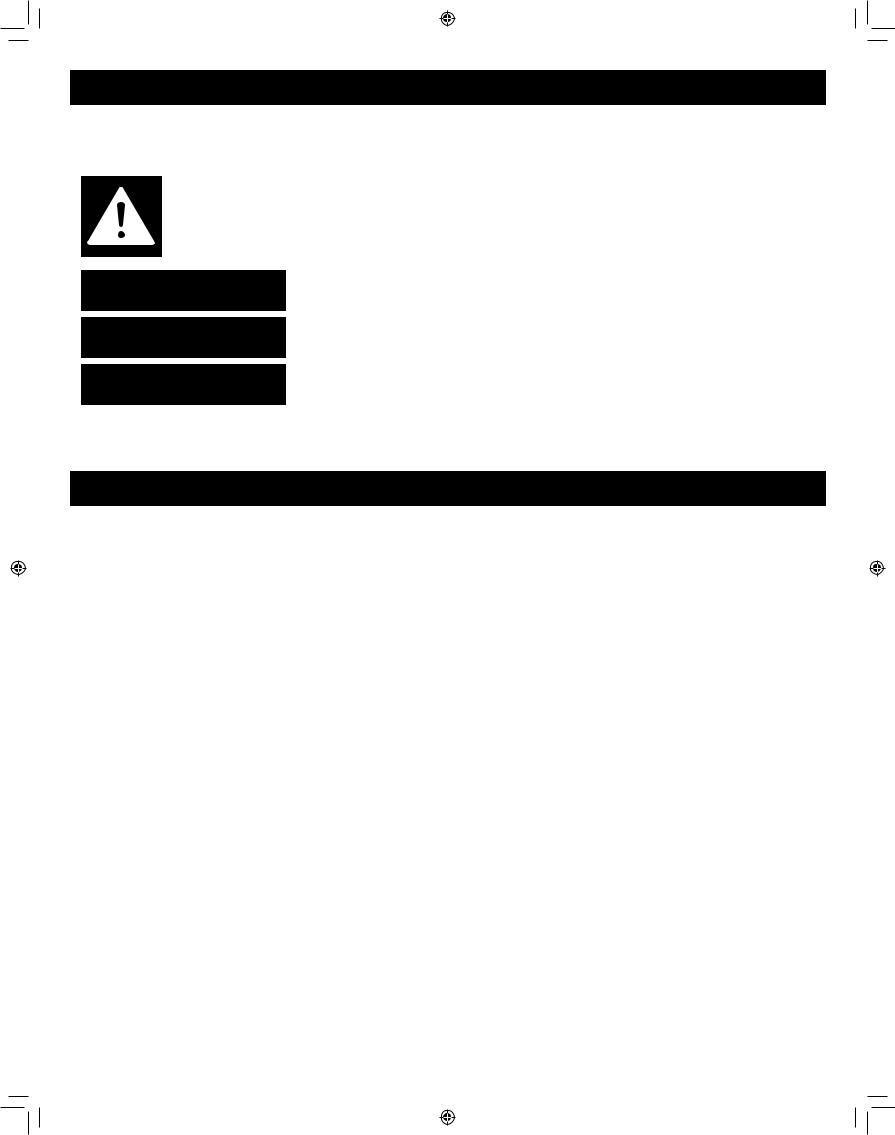
Important Safety Instructions
BASIC SAFETY PRECAUTIONS
This guide contains many important safety messages. Always read and obey all safety messages.
This is the safety alert symbol. It alerts you to safety messages that inform you of hazards that can kill or hurt you or others, or cause damage to the product.
All safety messages will be preceded by the safety alert symbol and the hazard signal word DANGER, WARNING or CAUTION. These words mean:
 DANGER
DANGER
 WARNING
WARNING
 CAUTION
CAUTION
You will be killed or seriously injured if you do not follow instructions.
You can be killed or seriously injured if you do not follow instructions.
Indicates an imminently hazardous situation which, if not avoided, may result in minor or moderate injury, or product damage.
All safety messages will identify the hazard, tell you how to reduce the chance of injury, and tell you what can happen if the instructions are not followed.
 WARNING
WARNING
To reduce the risk of fire, electric shock, or personal injury when using your product, basic safety precautions should be followed, including the following.
Read all instructions before using this appliance.
•NEVER unplug your refrigerator by pulling on the power cord. Always grip the plug firmly and pull it straight out from the outlet.
•If the supply cord is damaged, it must be replaced by the manufacturer or its service agent or a similarly
qualified person in order to avoid a hazard. Do not use a cord that shows cracks or abrasion damage along its length or at either the plug or connector end.
•Do not modify or extend the power cord length. It could cause electric shock or fire.
•When moving your refrigerator away from the wall, be careful not to roll over or damage the power cord.
•DO NOT store or use gasoline or other flammable vapors and liquids in the vicinity of this or any other appliance.
•DO NOT allow children to climb, stand, or hang on the refrigerator doors or shelves in the refrigerator. They could damage the refrigerator and seriously injure themselves.
•Keep fingers out of pinch point areas; clearances between the doors and cabinets are necessarily small. Be careful closing doors when children are in the area.
•Unplug your refrigerator before cleaning or making any repairs.
•If connected to a circuit protected by fuses, use time delay fuse.
•This appliance is not intended for use by persons (including children) with reduced physical, sensory or mental capabilities, or lack of experience and
knowledge, unless they have been given supervision or instruction concerning the use of the appliance by a person responsible for their safety.
•Keep ventilation openings, in the appliance enclosure or in the built-in structure, clear of obstruction.
•Do not use mechanical devices or other means to accelerate the defrosting process, other than those recommended by the manufacturer.
•Do not damage the refrigerant circuit.
•Do not use electrical appliances inside the food storage compartments of the appliance, unless they are of the type recommended by the manufacturer.
•The refrigerant and insulation blowing gas used in the appliance require special disposal procedures.
When disposing, please consult with service agent or a similarly qualified person.
NOTE: It is strongly recommended that any service be performed by a qualified technician.
SAVE THESE INSTRUCTIONS
5
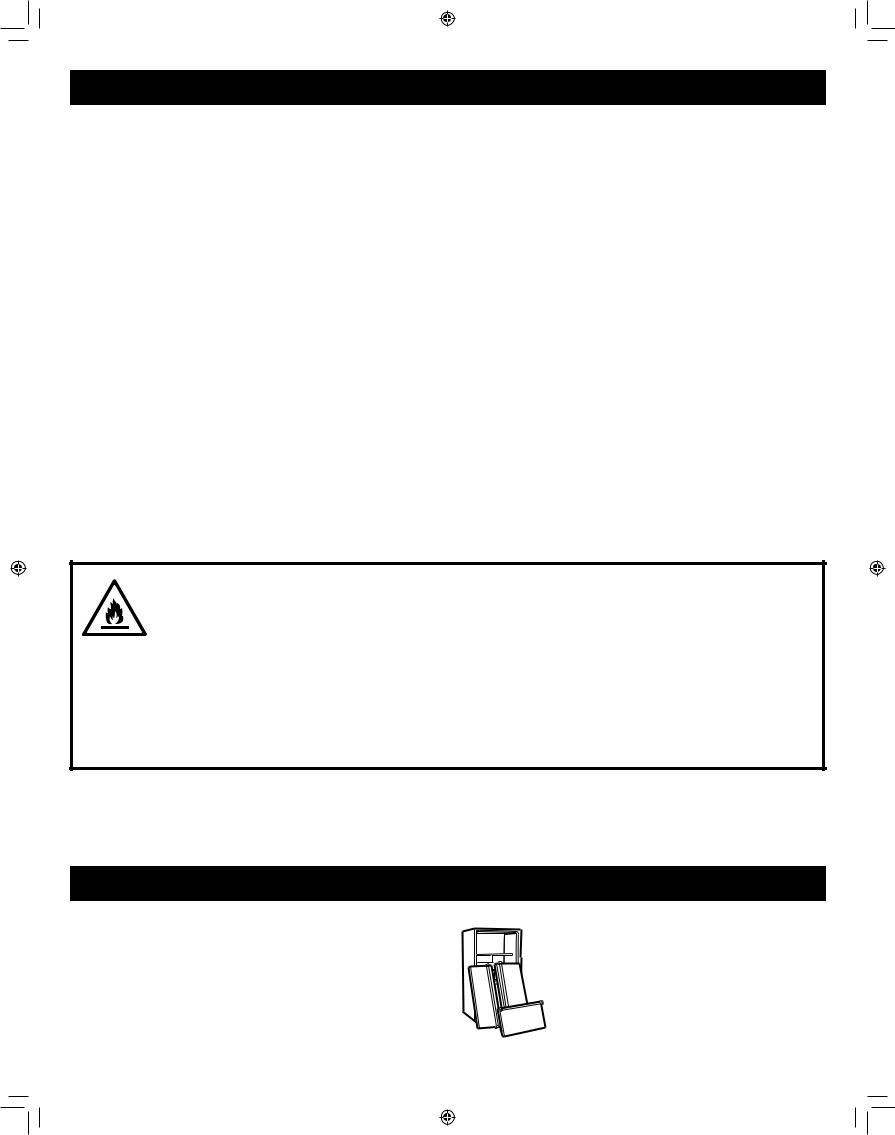
 WARNING
WARNING
•Before replacing a burned-out or broken light bulb, unplug the refrigerator or turn off power at the circuit breaker or fuse box in order to avoid contact with a live wire filament. (A burned-out light bulb may break when being replaced exposing the wire filament.)
NOTE: Some models have LED interior lighting and service should be performed by a qualified technician.
WARNING: Setting either or both controls to the OFF position does not remove power to the light circuit.
•When you are finished, reconnect the refrigerator to the electrical source and reset the controls (Thermostat, Refrigerator Control, and or Freezer Control, depending on the model) to the desired setting.
•This refrigerator must be properly installed in accordance with the Attention Installer Instructions that were taped to the front of the refrigerator.
•After your refrigerator is in operation, do not touch the cold surfaces in the freezer compartment when hands are damp or wet. Skin may adhere to the extremely cold surfaces.
•DO NOT touch the automatic ice making mechanism while the refrigerator is plugged in.
•DO NOT refreeze frozen foods which have thawed completely. The United States Department of Agriculture in Home and Garden Bulletin No. 69 says:
…You may safely refreeze frozen foods that have thawed if they still contain ice crystals or if they are still cold—below 39°F (4°C).
…Thawed ground meats, poultry or fish that have any off-odor or off-color should not be refrozen and should not be eaten. Thawed ice cream should be discarded.
If the odor or color of any food is poor or questionable, dispose of it. The food may be dangerous to eat.
Even partial thawing and refreezing reduces the eating quality of foods, particularly fruits, vegetables and prepared foods. The eating quality of red meats is affected less than that of many other foods. Use refrozen foods as soon as possible to save as much of their quality as you can.
•This product is not to be used for special purposes such as the storage of medicine or test materials or for use on ships, etc.
•Do not strike or apply excessive force to any glass surface. Do not touch glass surfaces if they are cracked or broken.
This appliance contains a small amount of isobutane refrigerant (R600a), but which is also combustible. When transporting and installing the appliance, care should be taken to ensure that no parts of the refrigerating circuit are damaged. Refrigerant squirting out of the pipes could ignite or cause an eye injury. If a leak is detected, avoid any naked flames or potential sources of ignition and air the room in which the appliance is standing for several minutes.
In order to avoid the creation of a flammable gas air mixture if a leak in the refrigerating circuit occurs, the size of the room in which the appliance may be sited depends on the amount of refrigerant used. The room must be 10.8 square feet (1 square meter) in size for every 8g of R600a refrigerant inside the appliance. The amount of refrigerant in your particular appliance is shown on the identification plate inside the appliance. Never start up an appliance showing any signs of damage. If in doubt, consult your dealer.
SAVE THESE INSTRUCTIONS
 DANGER: RISK OF CHILD ENTRAPMENT
DANGER: RISK OF CHILD ENTRAPMENT
Junked or abandoned refrigerators are dangerous, even if they are sitting for only a few days. If you are getting rid of your old refrigerator, please follow the instructions at right to help prevent accidents (child entrapment and suffocation).
BEFORE YOU THROW AWAY YOUR OLD REFRIGERATOR OR FREEZER:
•Take off the doors.
•Leave the shelves in place so that children may not easily climb inside.
6
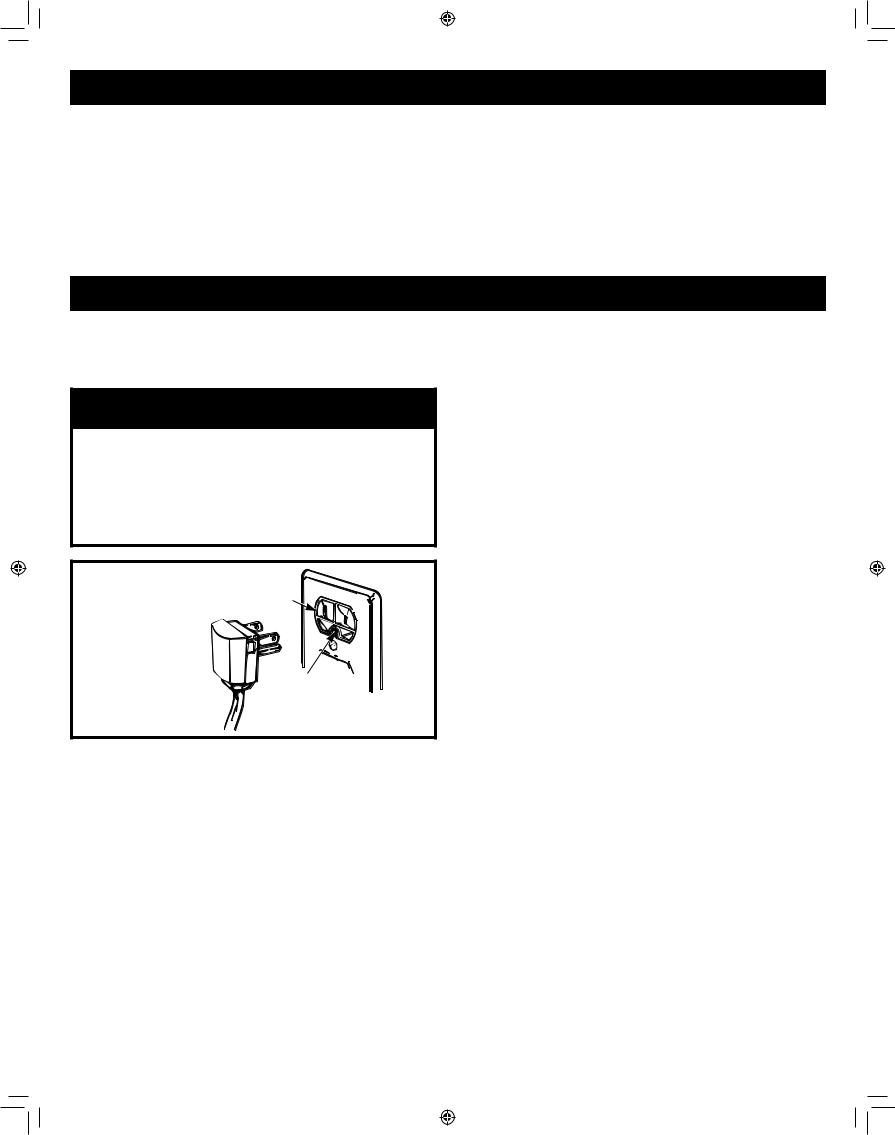
CFC/HCFC DISPOSAL
Your old refrigerator may have a cooling system that used CFCs or HCFCs (chlorofluorocarbons or hydrochlorofluorocarbons). CFCs and HCFCs are
believed to harm stratospheric ozone if released to the atmosphere. Other refrigerants may also cause harm to the environment if released to the atmosphere.
If you are throwing away your old refrigerator, make sure the refrigerant is removed for proper disposal by a qualified technician. If you intentionally release
refrigerant, you may be subject to fines and imprisonment under provisions of environmental legislation.
Electrical & Grounding Requirements
IMPORTANT: Please read carefully.
TO CONNECT ELECTRICITY
 WARNING
WARNING
Electrical Shock Hazard
FOR PERSONAL SAFETY, this appliance must be properly grounded. Have the wall outlet and the circuit checked by a qualified electrician to make sure the outlet is properly grounded.
3-prong grounding type
wall receptacle
3-prong grounding plug 
Ensure proper ground exists before use.
RECOMMENDED GROUNDING METHOD
The refrigerator should always be plugged into its own individual properly grounded electrical outlet rated for 115 Volts, 60 Hz, AC only, and fused at 15 or 20 amperes. This provides the best performance and also prevents overloading house wiring circuits which could cause a fire hazard from overheated wires. It is recommended that a separate circuit serving only this appliance be provided.
Use a receptacle that cannot be turned off with a switch or pull chain. Do not use an extension cord.
Where a standard two-prong wall outlet is encountered, it is your personal responsibility and obligation to have it replaced with a properly grounded three-prong wall outlet.
USE OF EXTENSION CORDS
Because of potential safety hazards under certain conditions, the use of an extension cord is not recommended. However, if you still elect to use an extension cord, it is absolutely necessary that it be a ULlisted (USA), 3-wire grounding type appliance extension cord having a grounding type plug and outlet, and that the electrical rating of the cord be 15 amperes (minimum) and 120 volts.
Use of an extension cord will increase the clearance needed for the back of the refrigerator.
7
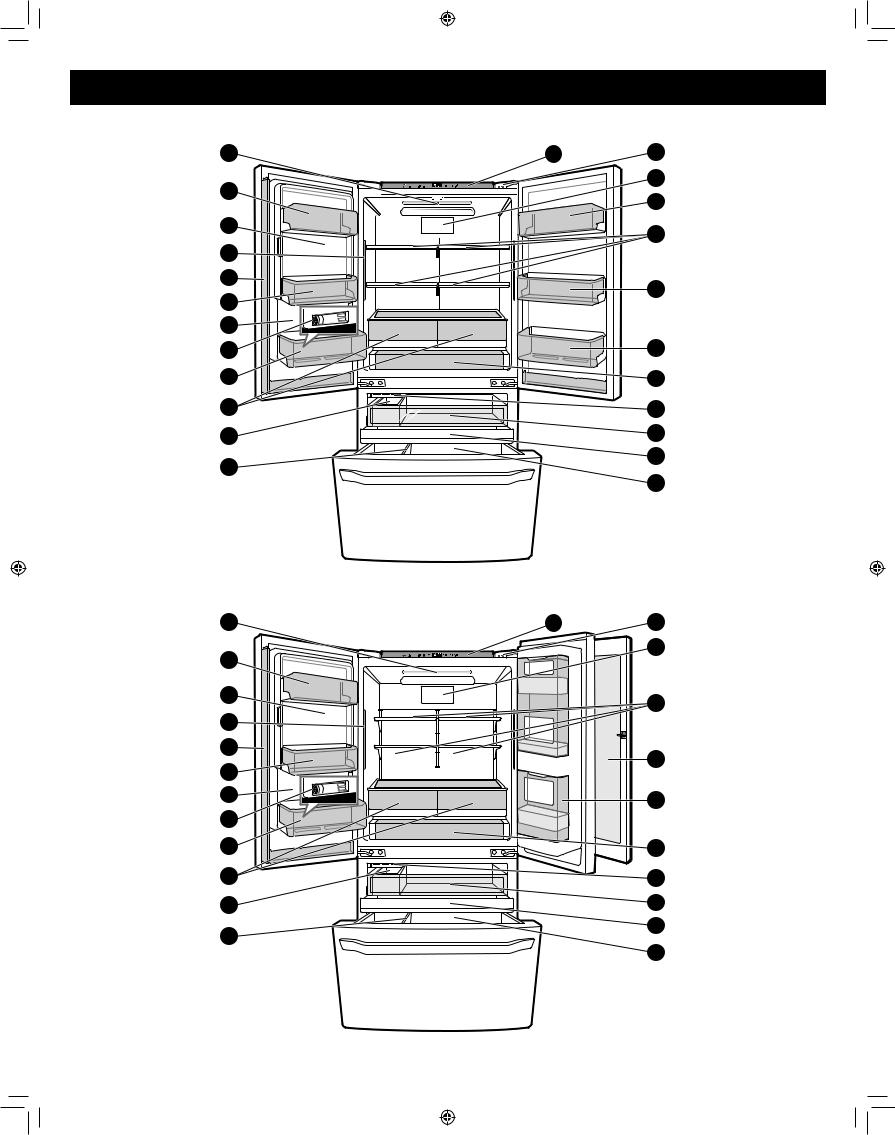
Parts and Features
• Standard Door
• PreView Grab-N-Go
A |
K |
L |
B |
|
M |
|
N |
|
|
|
|
C |
|
O |
D |
|
|
|
|
|
E |
|
N |
B |
|
|
|
|
|
F |
|
|
G |
|
N |
B |
|
P |
H |
|
Q |
I |
|
R |
J |
|
S |
|
T |
|
|
|
|
A |
K |
L |
B |
|
M |
|
|
|
C |
|
O |
D |
|
|
|
|
|
E |
|
U |
B |
|
|
|
|
|
F |
|
V |
G |
|
|
|
|
|
B |
|
P |
H |
|
Q |
I |
|
R |
J |
|
S |
|
T |
|
|
|
8
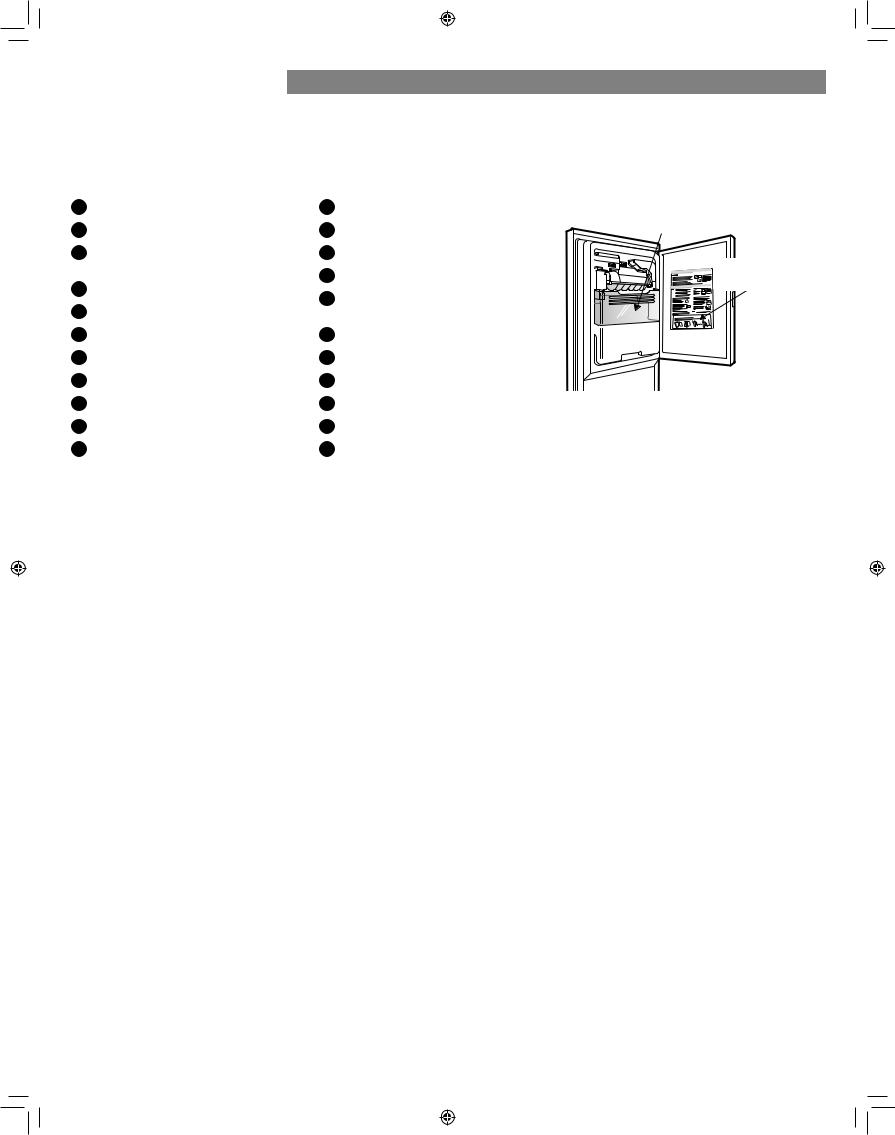
Parts and Features
Use this page to become more familiar with the parts and features of your refrigerator.
NOTE: This guide covers several different models. The refrigerator you have purchased may have some or all of the items listed below. The locations of the features shown below may not match your model.
A
B C
D
E
F
G H I J K
LED lighting Fixed Door Bins
In-door Ice Compartment (Icemaker and Ice Bin)
LED Lighting (side)
Articulating Mullion
Water Tank Cover Water Filter (interior)
Humidity Controlled Crisper Freezer Ice Bin
Durabase Divider Control Panel
L
M N
O
P
Q
R
S
T
U V
Diagnostics Speaker
Air Filter |
Ice Bin |
|
|
||
Adjustable Door Bins |
Ice Compartment |
|
Refrigerator Shelves |
||
Door |
||
Temperature Controlled Pantry |
||
|
||
Drawer |
|
|
Freezer Icemaker |
|
|
Top Pullout Drawer |
|
|
Middle Pullout Drawer |
|
|
Durabase |
|
|
PreView Grab-N-Go |
|
|
Grab-N-Go Case |
|
Product Specifications
The appearance and specifications listed in this manual may vary due to constant product improvements.
Electrical requirements: 115 V, 60 Hz
Min. / Max. water pressure: 20 – 120 psi (138 – 827 kPa)
|
Model 7440* |
|
|
Description |
Standard-depth, French door refrigerator, bottom freezer |
|
|
|
|
|
Model 7506* |
|
|
Description |
Counter-depth, French door refrigerator, bottom freezer |
|
|
|
|
|
Model 7507* |
|
|
Description |
Counter-depth, Preview Grab-N-Go French door refrigerator, bottom freezer |
|
|
9
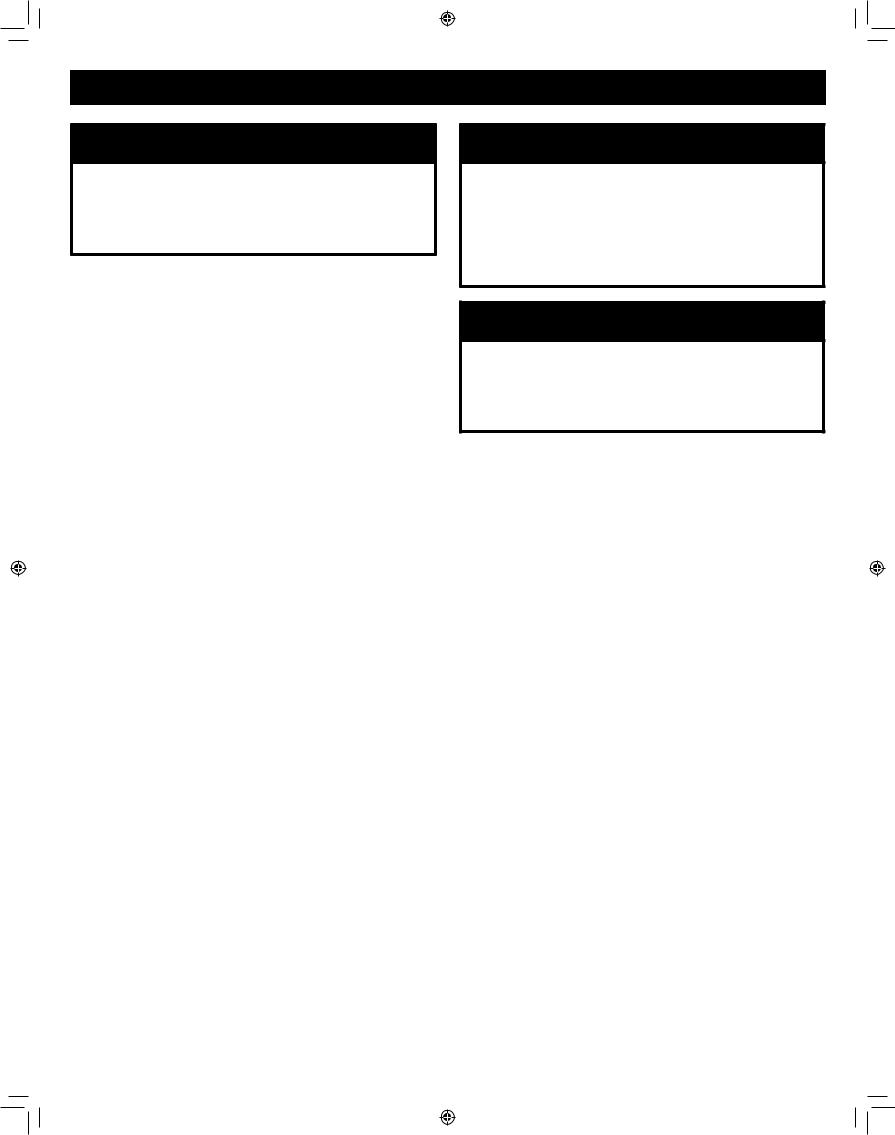
Refrigerator Installation
 WARNING
WARNING
Excessive Weight Hazard:
Use two or more people to move and install the refrigerator. Failure to do so can result in back or other injury.
UNPACKING YOUR REFRIGERATOR
Remove tape and any temporary labels from your refrigerator before using. Do not remove any warningtype labels, the model and serial number label, or the Tech Sheet that is located under the front of the refrigerator.
To remove any remaining tape or glue, rub the area briskly with your thumb. Tape or glue residue can also be easily removed by rubbing a small amount of liquid dish soap over the adhesive with your fingers. Wipe with warm water and dry.
Do not use sharp instruments, rubbing alcohol, flammable fluids, or abrasive cleaners to remove tape or glue. These products can damage the surface of your refrigerator.
Refrigerator shelves are installed in the shipping position. Please reinstall shelves according to your individual storage needs.
 WARNING
WARNING
Excessive Weight Hazard:
Your refrigerator is heavy. When moving the refrigerator for cleaning or service, be sure to protect the floor. Always pull the refrigerator straight out when moving it. Do not wiggle or walk the refrigerator when trying to move it, as floor damage could occur.
 WARNING
WARNING
Explosion Hazard:
Keep flammable materials and vapors, such as gasoline, away from the refrigerator. Failure to do so can result in fire, explosion, or death.
10

PRIOR TO USE
1.Clean your refrigerator thoroughly and wipe off all dust that accumulated during shipping.
2.Install accessories such as ice cube bin, drawers, shelves, etc., in their proper places. They are packed together to prevent possible damage during shipment.
3.Allow your refrigerator to run for at least two to three hours before putting food in it. Check the flow of cold air in the freezer compartment to ensure proper cooling. Your refrigerator is now ready for use.
INSTALLATION
The refrigerator should always be plugged into its own individual properly grounded electrical outlet rated for 115 Volts, 60 Hz, AC only, and fused at 15 or 20 amperes. This provides the best performance and also prevents overloading house wiring circuits which could cause a fire hazard from overheated wires. It is recommended that a separate circuit serving only this appliance be provided.
This appliance is intended to be used in household and similar applications such as staff kitchen areas in shops, offices and other working environments; farm houses and by clients in hotels, motels and other residential type environments; bed and breakfast type environments; catering and similar non-retail applications.
 WARNING
WARNING
Shock Hazard:
To reduce the risk of electric shock, do not install the refrigerator in a wet or damp area.
REFRIGERATOR INSTALLATION
INSTALLATION (continued)
1.To avoid noise and vibration, the unit must be leveled and installed on a solidly constructed floor. If required, adjust the leveling legs to compensate for unevenness of the floor. The front should be slightly higher than the rear to aid in door closing. Leveling legs can be turned easily by tipping the cabinet slightly. Turn the leveling legs to the left to raise the unit or to the right to lower it. (See Leveling and Door AlIgnment.)
NOTE: Installing on carpeting, soft tile surfaces, a platform or weakly supported structure is not recommended.
2.Install this appliance in an area where the temperature is between 55°F (13°C) and 110°F (43°C). If the temperature around the appliance is too low or high, cooling ability may be adversely affected.
3.Select a place where a water supply can be easily connected for the automatic icemaker.
NOTE: The water pressure must be from 20-120 psi or 138-827 kPa or 1.4-8.4 kgf/cm². If the refrigerator is installed in an area with low water pressure (below 20 psi), you can install a booster pump to compensate for the low pressure.
4.Too small of a distance from adjacent items may result in lowered freezing capability and increased electricity consumption charges. Allow at least 24 inches (61 cm) in front of the refrigerator to open the doors and at least 2 inches (5.08 cm) between the back of the refrigerator and the wall.
2" (5.08 cm) |
11
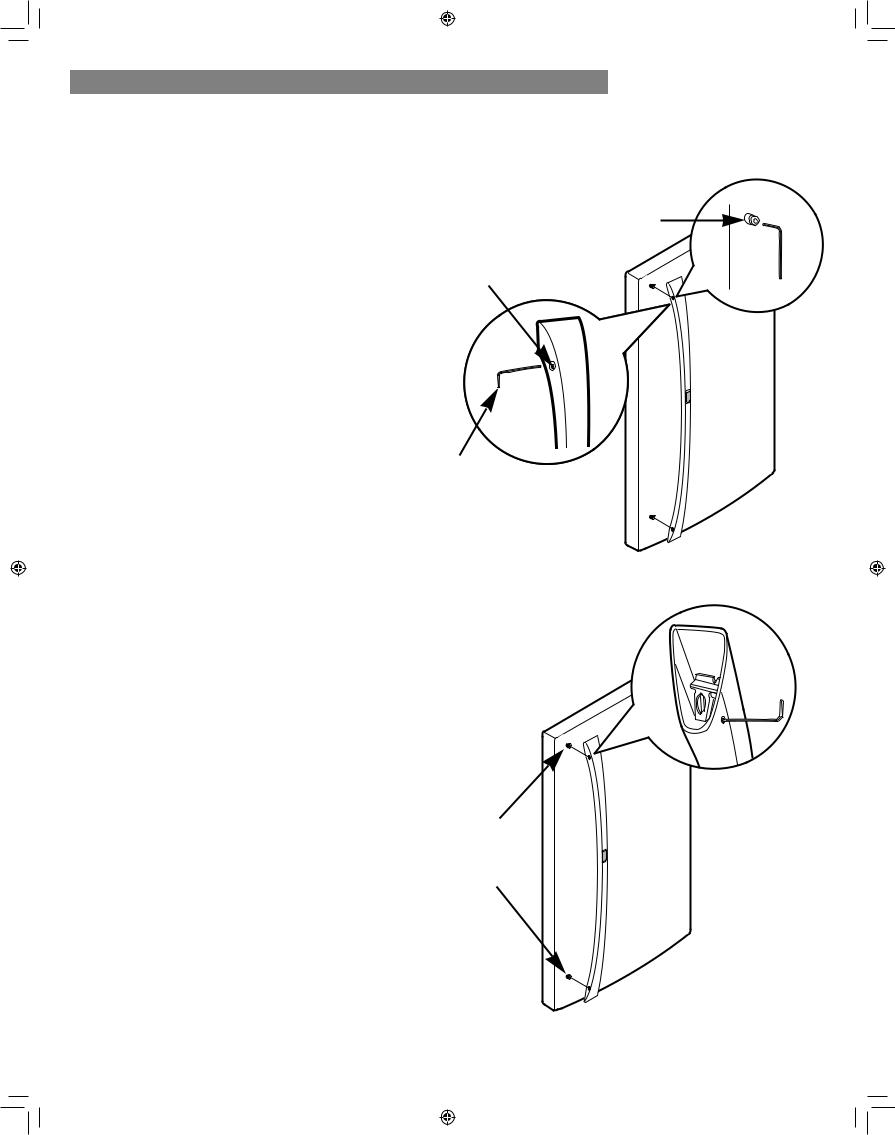
REFRIGERATOR INSTALLATION
NOTE: Removing the doors is always recommended when it is necessary to move the refrigerator through a narrow opening. If it is necessary to remove the handles, follow the directions below.
How to Remove Refrigerator Door Handle
NOTE: Handle appearance may vary from the illustrations on this page.
Set Screw
Removing Refrigerator Handle
Loosen the set screws with a 3/32 in. Allen wrench and remove the handle.
NOTE: If the handle mounting fasteners need to be tightened or removed, use a ¼ in. Allen wrench.
Mounting
Fasteners
Allen
Wrench
How to Replace Refrigerator Door Handle
NOTE: Handle appearance may vary from the illustrations on this page.
Replacing Refrigerator Door Handle
Place the handle on the door by fitting the handle footprints over the mounting fasteners and tightening the set screws with a 3/32 in Allen wrench.
NOTE: If the handle mounting fasteners need to be tightened or removed, use a ¼ in. Allen wrench.
Mounting
Fasteners
12
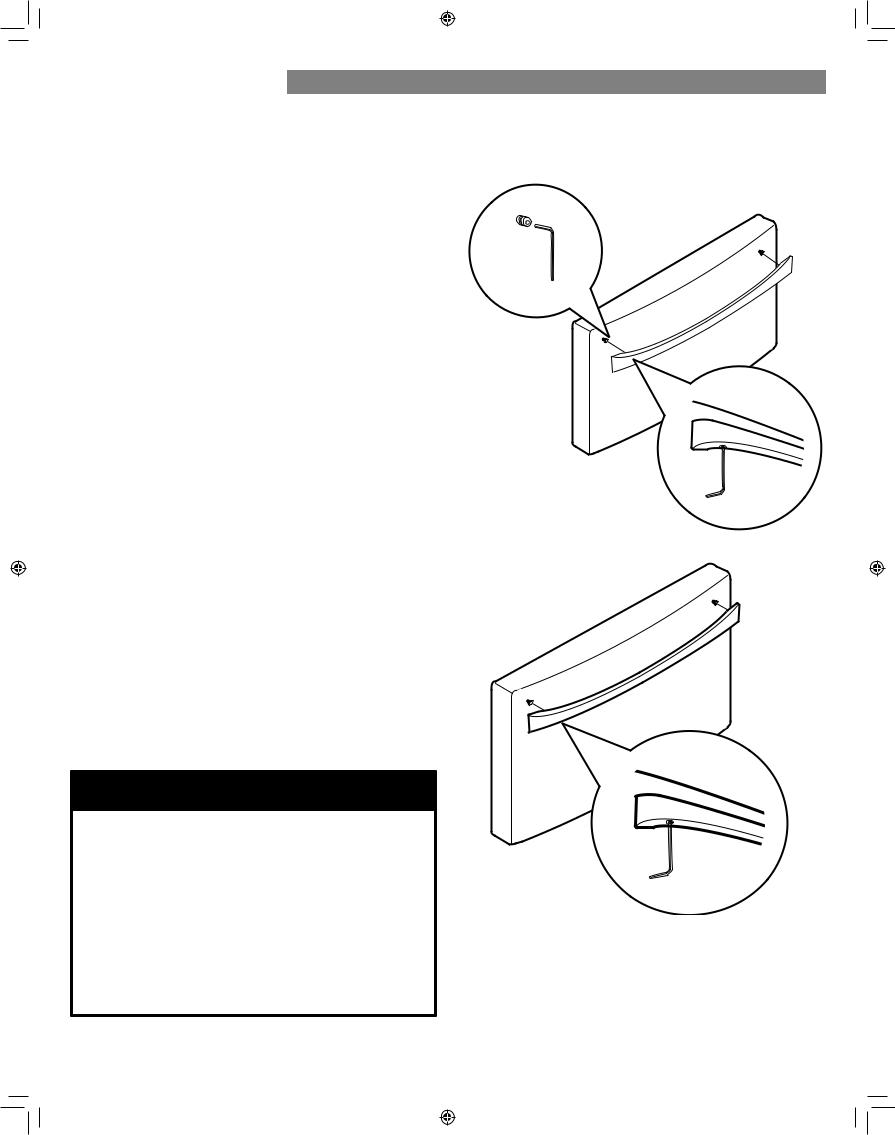
REFRIGERATOR INSTALLATION
NOTE: Removing the doors is always recommended when it is necessary to move the refrigerator through a narrow opening. If it is necessary to remove the handles, follow the directions below.
HOW TO REMOVE FREEZER DOOR HANDLE
NOTE: Handle appearance may vary from the illustrations on this page.
Removing Freezer Drawer Handle
Loosen the set screws located on the lower side of the handle with a ⅛ in. Allen wrench and remove the handle.
NOTE: If the handle mounting fasteners need to be tightened or removed, use a ¼ in. Allen wrench.
HOW TO REPLACE FREEZER DOOR HANDLE
NOTE: Handle appearance may vary from the illustrations on this page.
Replacing Freezer Drawer Handle
Place the handle on the door by fitting the handle footprints over the mounting fasteners and tightening the set screws with a ⅛ in. Allen wrench.
NOTE: If the handle mounting fasteners need to be tightened or removed, use a ¼ in. Allen wrench.
 WARNING
WARNING
When assembling or disassembling the handles:
•Grasp the handle firmly to ensure it will not drop or cause injury.
•Prevent the handle from swinging toward nearby people or animals.
•Insert the bracket hole of the handle into the stopper bolt of the door exactly, then assemble the set screws to fix the handle in place.
•Check for any gap between the door and handle after the handle is fixed in place.
13
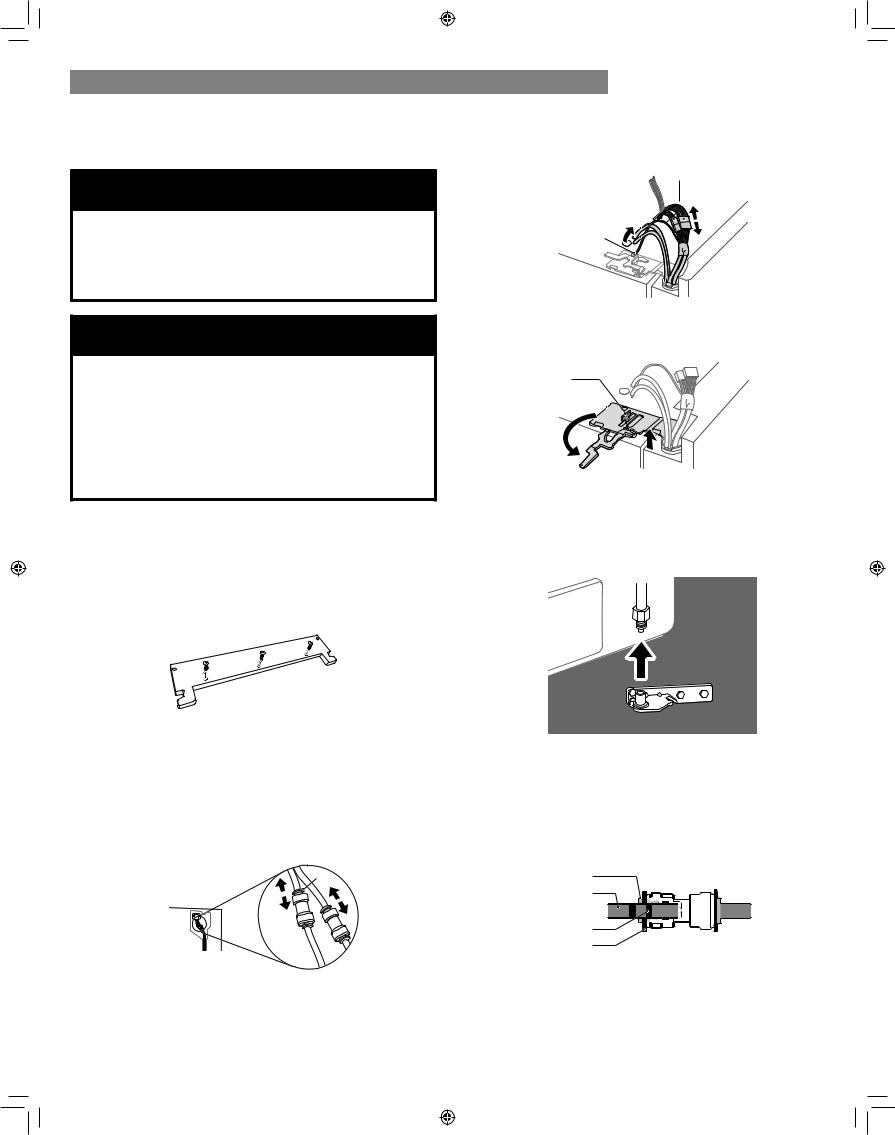
REFRIGERATOR INSTALLATION
Removing and Replacing
Refrigerator Doors
 WARNING
WARNING
Excessive Weight Hazard:
Use two or more people to remove and install the refrigerator doors. Failure to do so can result in back or other injury.
 WARNING
WARNING
Electrical Shock Hazard
•Disconnect the electrical supply to the refrigerator before installing. Failure to do so could result in serious injury or death.
•Do not put hands, feet or other objects into the air vents or bottom of the refrigerator. You may be injured or receive an electrical shock.
Removing the Hinge Cover
Remove the screw from the hinge cover at the top of the refrigerator. Lift the hook (not visible), located at the bottom of the front side of the cover with a flat-heat screwdriver.
Removing the Left Door
1.The water supply is connected to the upper right part of the rear surface of the refrigerator.
Remove the clip in the joint area. Hold the water supply connection and gently push the collet (1) to detach the water supply line as shown.
(1)
2. |
Pull out the tube (2). Disconnect all wire harnesses (3). |
|
Unscrew the ground wire (4). |
|
(2) |
|
(3) |
|
(4) |
3. |
Rotate the hinge lever counterclockwise (5). Lift the |
|
top hinge (6) free of the hinge lever latch (7). |
|
(7) |
|
(6) |
(5)
 CAUTION: When lifiting the hinge free of the latch, be careful that the door does not fall forward.
CAUTION: When lifiting the hinge free of the latch, be careful that the door does not fall forward.
4.Lift the door from the middle hinge pin and remove the door.
NOTE: Place the door, inside facing up, on a nonscratching surface.
NOTE
Disassembling/Assembling the Water Lines
Collet
Tube |
Insert line |
|
Clip |
(Correct) |
14
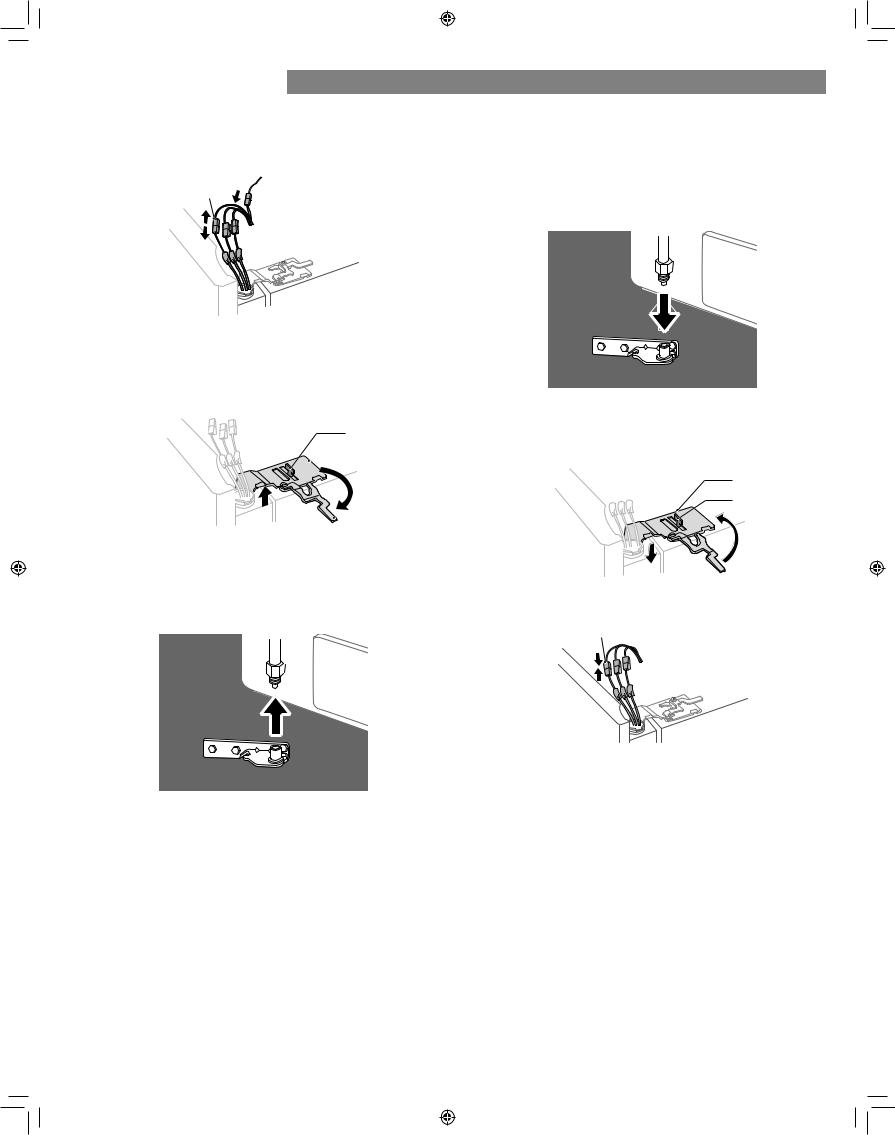
Removing the Right Door
1.Detach all the wire harnesses (1).
(1)

NOTE: The number of wire harnesses may vary depending on the model.
2.Rotate the hinge lever (2) clockwise. Lift the top hinge
(3) free of the hinge lever latch (4).
(4)
(3)
(2)
 CAUTION: When lifiting the hinge free of the latch, be careful that the door does not fall forward.
CAUTION: When lifiting the hinge free of the latch, be careful that the door does not fall forward.
3.Lift the door from the middle hinge pin and remove the door.
REFRIGERATOR INSTALLATION
Replacing the Right Door
Install the right-side door first.
1.Make sure that the plastic sleeve is inserted in the bottom of the door. Install the refrigerator door onto the middle hinge.
2.Fit the hinge (1) over the hinge lever latch (2) and slot it into place. Rotate the lever (3) counterclockwise to secure the hinge.
(1)
(2)
 (3)
(3)
3. Connect all the wire harnesses (4).
(4)
NOTE: The number of wire harnesses may vary depending on the model.
NOTE: Place the door, inside facing up, on a nonscratching surface.
15
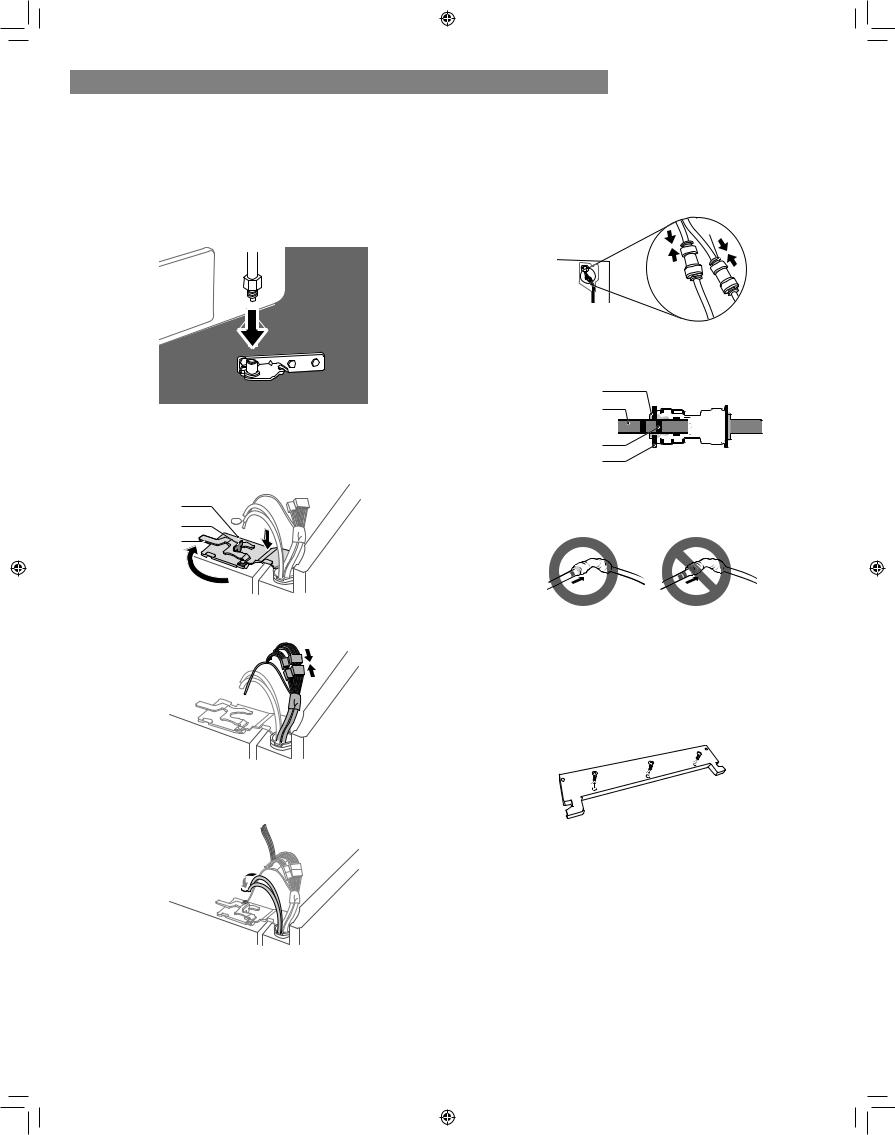
REFRIGERATOR INSTALLATION
Replacing the Left Door
Install the left refrigerator door after the right door installed.
1.Make sure that the plastic sleeve is inserted in the bottom of the door. Install the refrigerator door onto the middle hinge.
2.Fit the hinge (1) over the hinge lever latch (2) and slot it into place. Rotate the lever (3) counterclockwise to secure the hinge.
(1)
(2)
(3)
5.Hold the water supply connection and gently push in the collect (4) to connect the water supply line as shown. Insert the tube at least ⅝ in. (15 mm) into the connector. Insert the clip on the joint to fasten the tube in place.
(4)
NOTE
Disassembling/Assembling the Water Lines
Collet
Tube
Insert line |
|
Clip |
(Correct) |
•Gently press the collet and insert the tube until only one line shows on the tube.
3. Connect all the wire harnesses and the ground screw.
4.Push the water supply lines into the hole on the top case and pull it through the backplate.
(Correct) (Incorrect)
Replacing the Hinge Cover
Position the hinge coverin its place. Insert and thighten the cover screws.
16
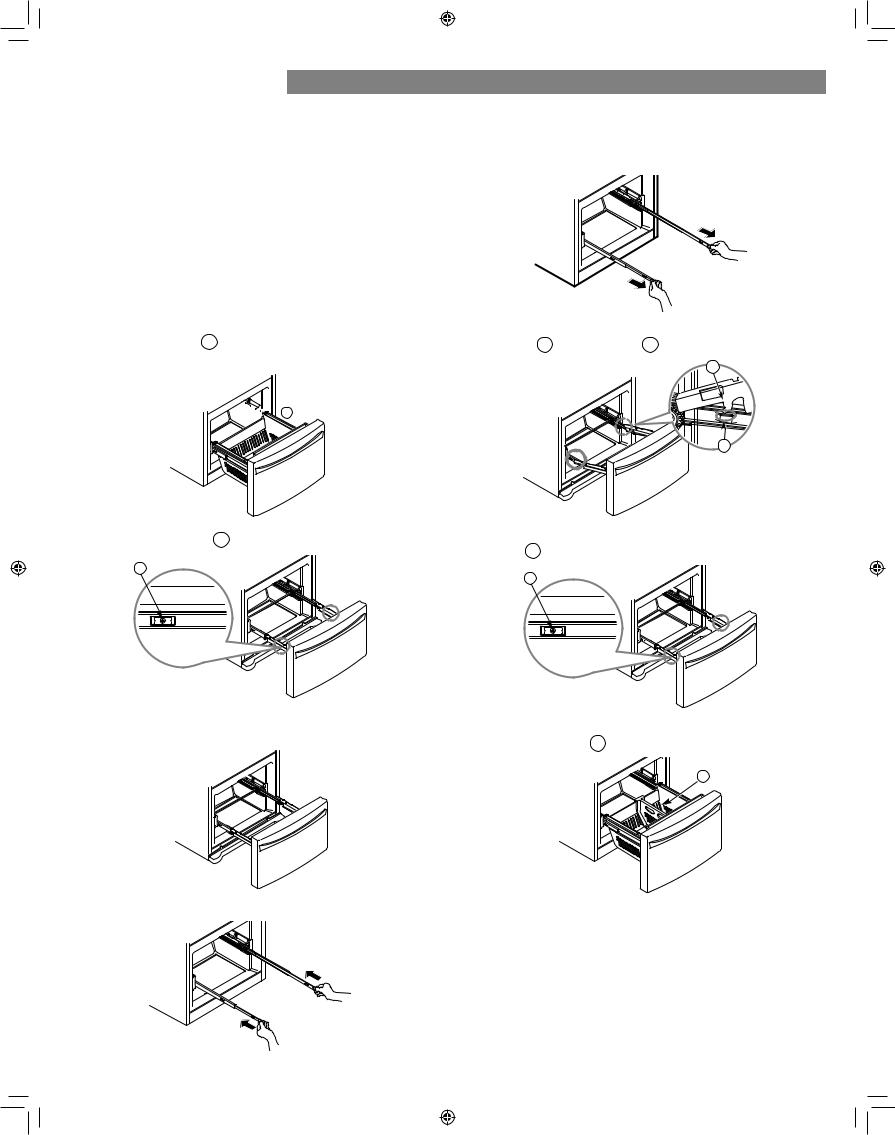
HOW TO REMOVE THE FREEZER DRAWER
 WARNING: Use two or more people to remove and install the freezer drawer. Failure to do so can result in back or other injury.
WARNING: Use two or more people to remove and install the freezer drawer. Failure to do so can result in back or other injury.
 CAUTION: Do not hold the handle when removing or replacing the drawer. The handle may come off and it could cause personal injury.
CAUTION: Do not hold the handle when removing or replacing the drawer. The handle may come off and it could cause personal injury.
NOTE: In the following figures, the Pullout Drawer located above the freezer drawer is not shown for clarity.
Pull the drawer open to full extension. Remove the Durabase basket 1 by lifting the basket from the rail system.
 1
1
REFRIGERATOR INSTALLATION
HOW TO INSTALL THE FREEZER DRAWER
Pull out each rail to full extension.
Grasp the drawer on each side and hook drawer supports 1 into rail tabs 2 located on both sides.
1
2
Remove the screws |
2 from the rail on both sides. |
Lower the door into its final position and tighten the |
||
screws 3 |
located on both sides. |
|||
|
|
|||
2 |
|
3 |
|
|
|
|
|
||
Grasp the drawer on each side and pull it up to separate it from the rails.
With both hands, slide the bars in simultaneously.
With the drawer pulled out to full extension, insert the Durabase basket 4 in the rail assembly.
4
 WARNING: If the Durabase divider is removed, there is enough open space for children or pets to crawl inside. To prevent accidental child and pet entrapment or suffocation risk, DO NOT allow them to touch or go near the freezer drawer.
WARNING: If the Durabase divider is removed, there is enough open space for children or pets to crawl inside. To prevent accidental child and pet entrapment or suffocation risk, DO NOT allow them to touch or go near the freezer drawer.
 WARNING: DO NOT step or sit down on the freezer drawer.
WARNING: DO NOT step or sit down on the freezer drawer.
17
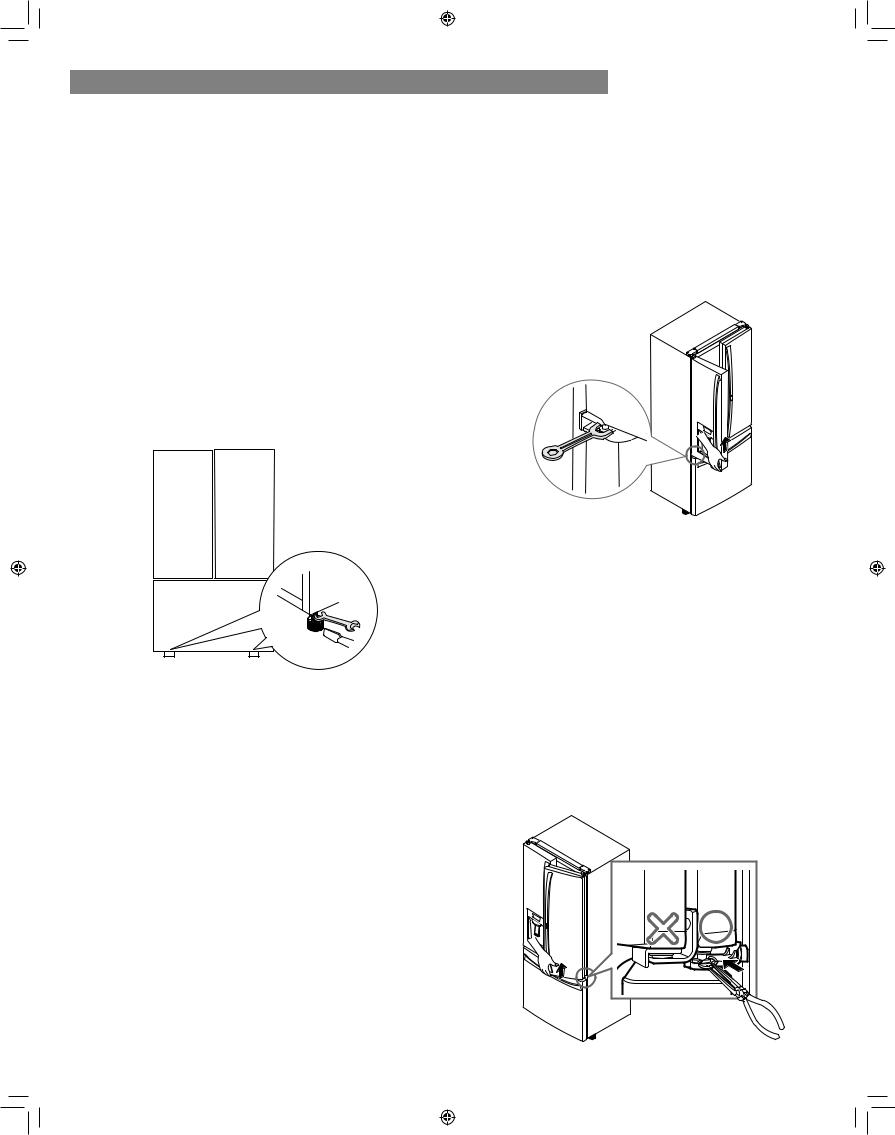
REFRIGERATOR INSTALLATION
Leveling and Door Alignment
Leveling
After installing, plug the refrigerator’s power cord into a 3-prong grounded outlet and push the refrigerator into the final position.
Your refrigerator has two front leveling legs—one on the right and one on the left. Adjust the legs to alter the tilt from front-to-back or side-to-side. If your refrigerator seems unsteady, or you want the doors to close more easily, adjust the refrigerator’s tilt using the instructions below:
NOTE: Tools Required: 11/16" wrench or flat blade screwdriver.
1.Turn the leveling leg to the left to raise that side of the refrigerator or to the right to lower it. It may take several turns of the leveling leg to adjust the tilt of the refrigerator.
NOTE: Having someone push backward against the top of the refrigerator takes some weight off of the leveling legs. This makes it easier to adjust the legs.
2.Open both doors again and check to make sure that they close easily. If the doors do not close easily, tilt the refrigerator slightly more to the rear by turning both leveling legs to the left. It may take several more turns, and you should turn both leveling legs the same amount.
NOTE: Your refrigerator is uniquely designed with two fresh food doors. Either door can be opened or closed independently of the other. You may have to exert slight pressure on the doors to get them to close completely.
Door Alignment
The left refrigerator door has an adjustable nut, located on the bottom hinge, to raise and lower the door for proper alignment.
If the space between your doors is uneven, follow the instructions below to align the doors evenly:
Use the wrench (included with the Use & Care Guide) to turn the nut in the door hinge to adjust the height. To the right to raise or to the left to lower the height.
The right refrigerator door does not have an adjustable nut.
If the space between your doors is uneven, follow the instructions below to align the right door:
1.With one hand, lift up both the inner and outer door sections of the right door to raise them at the middle hinge. (Opening the door may make lifting it easier)
2.With the other hand, use pliers to insert the snap ring on the middle hinge of the inner door section as
shown. Do not insert the ring on the hinge of the outer door section.
3.Insert additional snap rings until the right door is aligned. (Two snap rings are provided with the unit.)
Outer |
Inner |
Door |
Door |
18
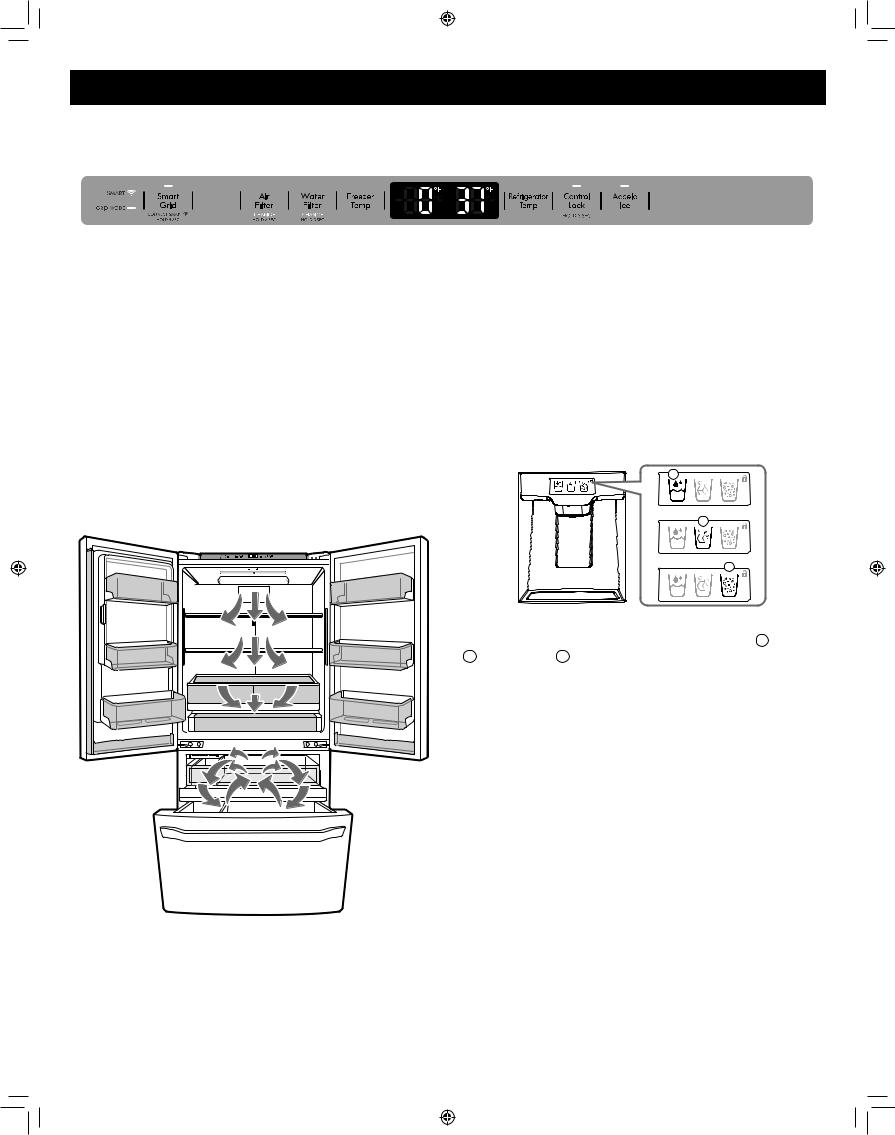
Using your Refrigerator
Setting the Controls
Temperature
•The Refrigerator Temp Control ranges from 33°F to
43°F (1°C to 7°C). Press the refrigerator temp button to cycle through the available temperature settings one increment at a time.
•The Freezer Temp Control range is from -7°F to 5°F
(-23°C to -15°C). Press the freezer temp button to cycle through the available temperature settings one increment at a time.
NOTE: When changing control settings, wait 24 hours before making additional adjustments. The controls are set correctly when milk or juice is as cold as you would like and when ice cream is firm. If the temperature in either compartment is too cold or too warm, change the setting one increment at a time. Wait 24 hours for the change to stabilize before adjusting again.
Airflow
Be sure not to block vents while packing your refrigerator.
Doing so will restrict airflow and may cause the refrigerator temperature to become too warm or cause interior moisture buildup. (See air flow diagram below.)
Dispenser
1
2
3
The dispenser will dispense water, cubed ice or crushed ice. Press the appropriate icon of your choice: ( 1 ) water ( 2 ) cubed ice ( 3 ) crushed ice. When pressed the icon will illuminate.
NOTE: The dispenser will not work if any door is left open or if the control lock is engaged.
NOTE: If the Control Lock icon is illuminated, the Dispenser will not work. Disable the Control Lock to use the Dispenser again.
 CAUTION: The control display is operated by touch. Excessive moisture on the display may cause a malfunction. Please keep the display clean and dry.
CAUTION: The control display is operated by touch. Excessive moisture on the display may cause a malfunction. Please keep the display clean and dry.
19
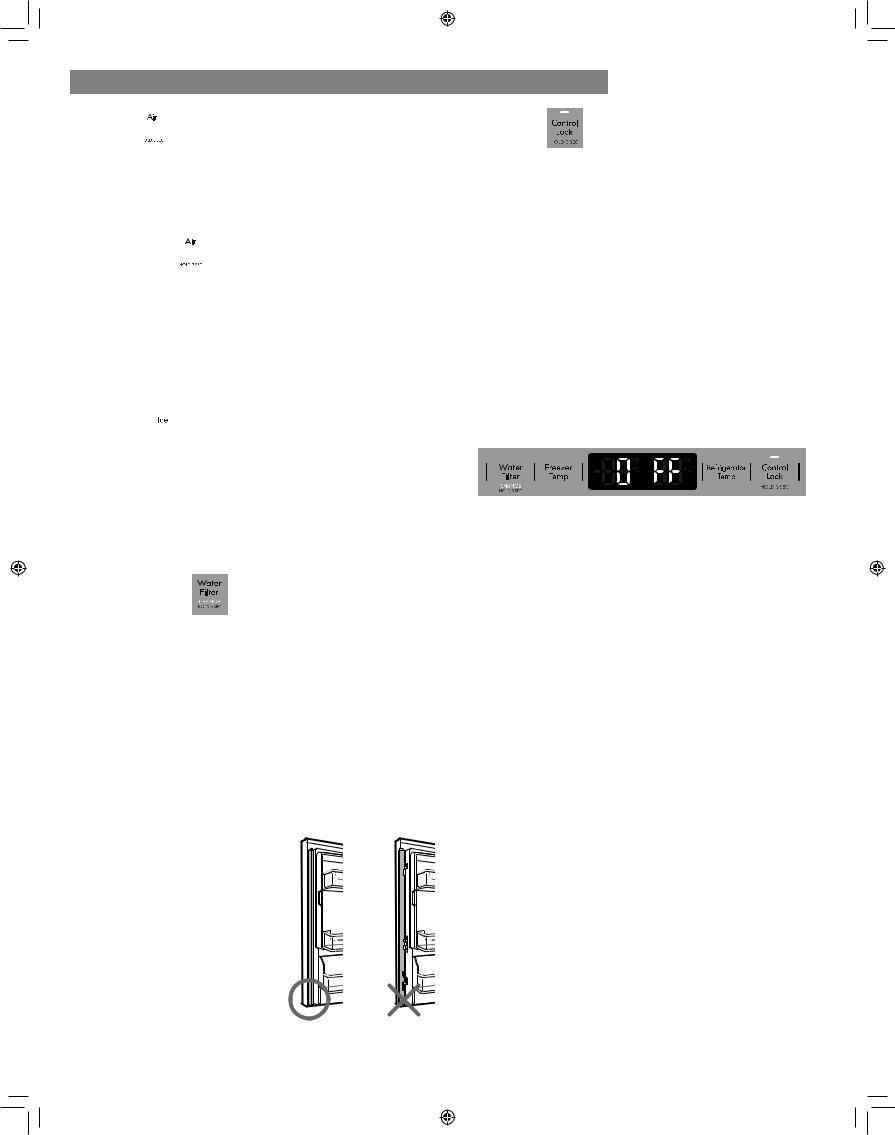
Using your Refrigerator
Air Filter 
The Air Filter helps remove odors from the refrigerator. The Air Filter will cycle on and off in increments of ten minutes on and 110 minutes off.
Air Filter Reset 
When the Change icon turns on, the air filter needs to be replaced. After replacing the air filter, press and hold the Air Filter button for three seconds to turn the icon light off. It is recommended to change the air filter approximately every 6 months.
Accela Ice 
•This function increases both ice making and freezing capabilities.
•When you press the Accela Ice button, the LED will light up and will remain on for 24 hours.
The function will automatically shut off after 24 hours.
•You can stop this function manually by pressing the button one more time.
Water Filter Reset
When the CHANGE icon turns on, you need to change the water filter. After changing the water filter, press and hold the Water Filter button for three seconds to turn the indicator light off. You need to change the water filter approximately every six months.
Articulating Mullion
This feature is a metal strip attached to the left door that articulates (rotates) 90 degrees as the door is closed, forming a mullion (base) for the left and right door gaskets to seal against.
 CAUTION:
CAUTION:
To reduce the risk of scratching the door or breaking the door mullion, make sure that the refrigerator door mullion is always folded in.
Control Lock
•When power is initially connected to the refrigerator, the Lock function is off.
•To lock the control panel and dispenser, press and hold the Control Lock button for 3 seconds or until the LED turns on.
•When the Lock function is activated, no other buttons will work. The dispenser pad is also deactivated.
•To unlock the controls and dispenser, press and hold the
Control Lock button until the LED turns off.
Demo Mode (For Store Use Only)
The Demo Mode disables all cooling in the refrigerator and freezer sections to conserve energy while on display in a retail store. When activated, OFF will display on the control panel.
To deactivate:
With either refrigerator door opened, press the Accela Ice button 3 times consecutively while pressing the Refrigerator Temp button. The control panel beeps and the temperature settings display to confirm that Demo Mode is deactivated. Use the same procedure to activate the Demo Mode.
Temperature Mode Switch Function (°F <->°C)
If you want to convert °F to °C or vice versa, press and hold the Freezer Temp and Refrigerator Temp buttons at the same time for approximately five seconds.
20
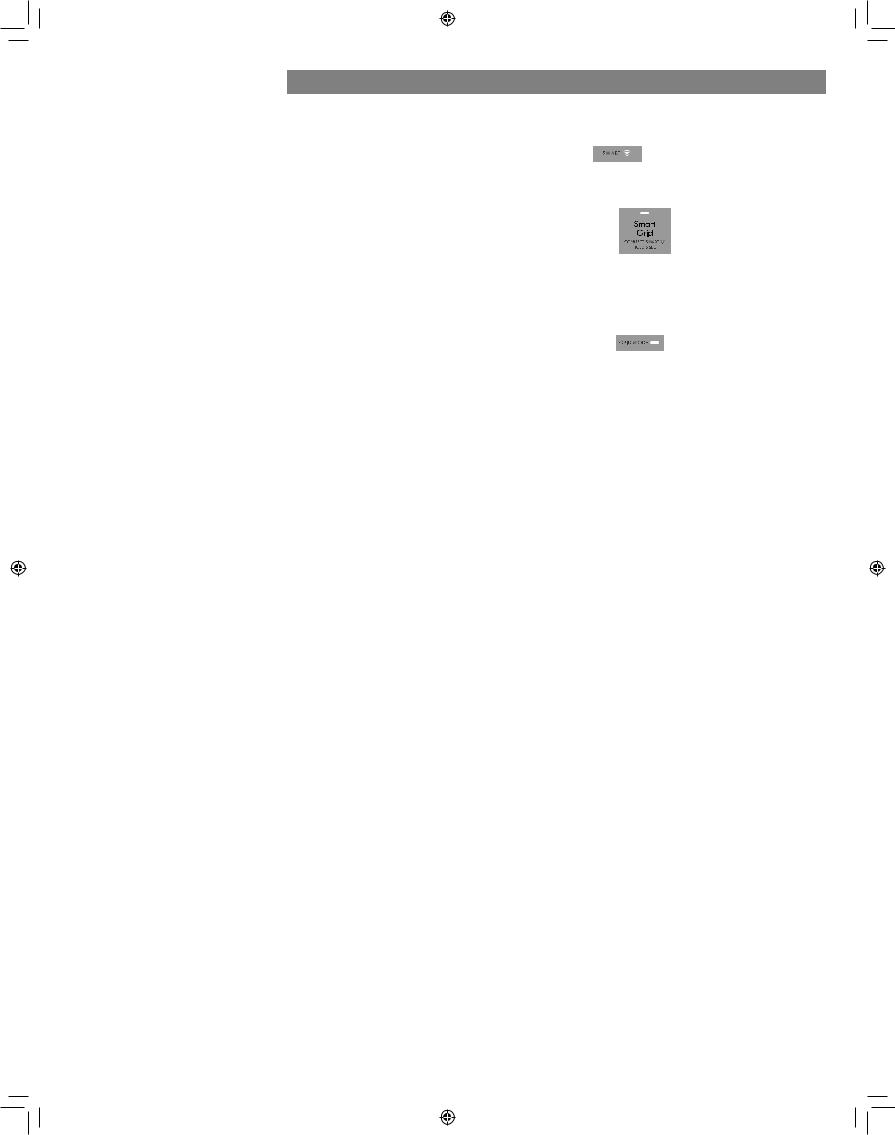
Smart Features
OVERVIEW
Kenmore Smart connectivity transforms your relationship with your home. You can personalize the way Kenmore Smart products operate based on your schedule and daily routines, making life easier and providing greater peace of mind. It does this by letting you link with and manage your Kenmore Smart products on one app, all from trusted brands, from a smart phone, tablet or computer.
This appliance is a connected-ready appliance, allowing you to remotely monitor and control it from your smart phone via the Kenmore® Smart app.
To get started, you will need the following:
•Kenmore Elite® Smart Appliance
•WI-FI home router connected to the internet
•Smart phone
•Kenmore Smart app
For more information about your Kenmore Elite® Smart appliance, please visit www.Kenmore.com/smart.
The Smart Grid function controls energy usage which helps you save energy during peak usage periods. You can override the SMART GRID function at any time (using the Smart Grid button or application).
Smart Grid responds to notification events from your utility company to run high energy-consuming tasks only during off-peak times when electrical demand is lower. These notification events are known as Demand Response
(DR) signals. If the refrigerator receives a DR signal from the utility company, the refrigerator will turn on the GRID MODE LED on the refrigerator control panel and regulate power consumption according to the signal received. The refrigerator will respond to the signals received from the utility company as long as the appliance is connected to the internet and Smart Grid is enabled.
Using your Refrigerator
DEFINITIONS
SMART LED (white):
Notifies the user that the appliance is connected to the internet.
Smart Grid LED (white):
Notifies the user that the appliance is capable of receiving a signal, known as a Demand Response event, from a utility company’s energy management system.
GRID MODE LED (red):
Notifies the user that the appliance is reducing or delaying energy use based on the signal received from a utility company energy management system. The LED will remain illuminated during critical peak pricing (CPP) and real time pricing (RTP) or during a high demand for electricity.
GETTING CONNECTED
You need the following devices and application to use the Smart Grid and other smart features on your refrigerator.
Required Devices: A wireless router, Kenmore Elite Smart Refrigerator, and a mobile device.
Required Application: Kenmore Smart App.
CONNECTING THE REFRIGERATOR
Refer to the Quick Start Guide that came with your smart appliance for detailed instructions on creating a Kenmore account and setting up the appliance for connected operation from your mobile device. For additional assistance, visit http://www.kenmore.com/smart
NOTE: When successfully connected to the internet, the SMART icon LED on the unit control panel will turn ON.
21

Using your Refrigerator
Instructions for Smart Grid
IMPORTANT:
You must connect your Kenmore Smart appliance to the internet and then register the appliance to your account in order to use the Smart Grid function.
Consult the Quick Start Guide supplied with the appliance for instructions on how to register your appliance using the Kenmore application (app).
The Smart Grid Button serves two purposes:
1) internet connection or disconnection, 2) enable or disable/override the appliance Demand Response capability.
NOTE: This appliance is a connected-ready appliance, allowing you to remotely monitor and control it from your smart phone via the Kenmore® Smart app.
To connect the refrigerator to the Internet:
Refer to the Quick Start Guide that came with your smart appliance for detailed instructions on creating a Kenmore account and setting up your appliance for connected operation from your smart phone. This Use & Care Guide contains information and instructions for operating
your appliance from the appliance control panel. For additional assistance, visit http://www.kenmore.com/ smart
NOTE: If no connection is made after 10 minutes the blinking SMART GRID button LED will turn off.
Smart Grid Operation:
Once connected and registered, the appliance is capable of accepting a signal from your electrical company. The signal, known as a Demand Response (DR), will adjust refrigerator operation to reduce power consumption for a period of time ranging from a few minutes up to a maximum of 4 hours. Ice making will be delayed during this time. Opening the refrigerator door may cancel certain DR signals.
The Grid Mode LED (red) will be steadily lit when the signal is in effect. To disable the signal and prevent further signal acceptance, press and release the Smart Grid button. Both the Grid Mode and Smart Grid LED will turn off. Press and release the Smart Grid button again to enable DR signal acceptance capability. The Smart Grid button LED will relight. The Grid Mode LED will light when another DR signal is sent.
22
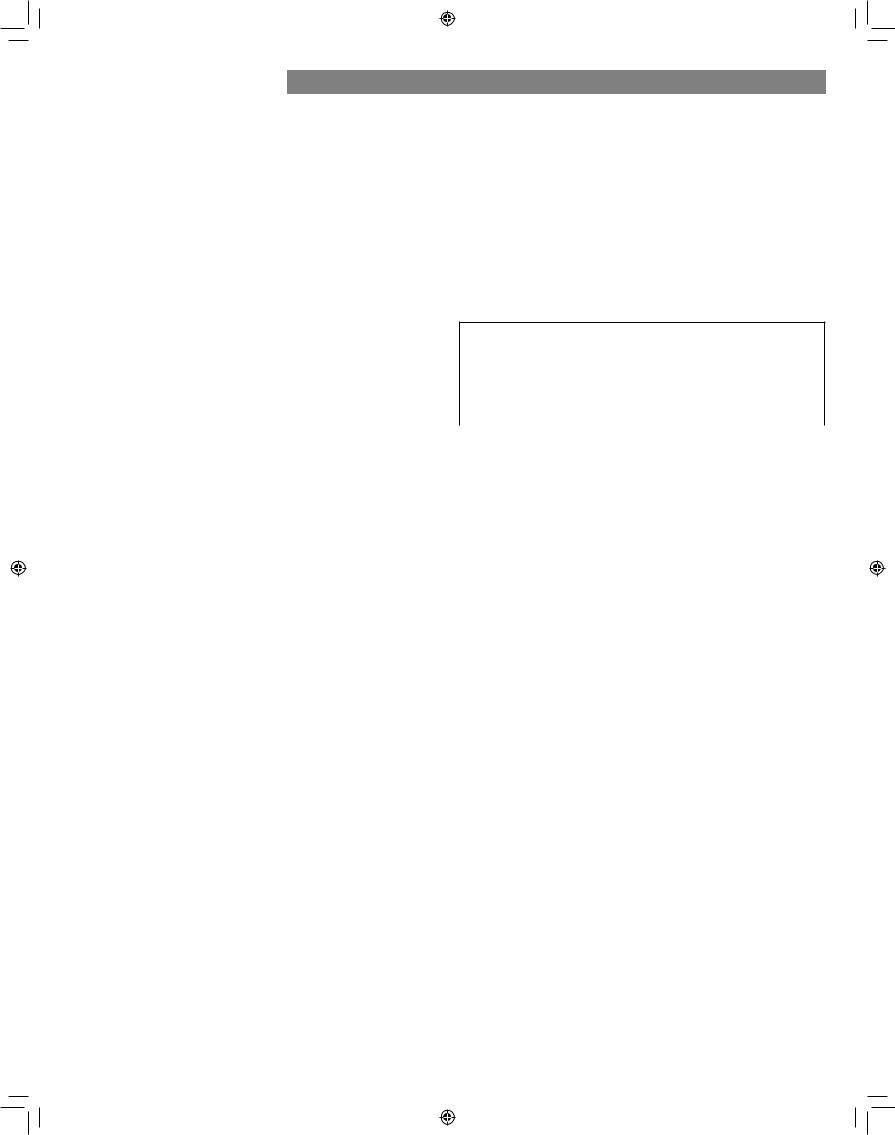
FCC Notice
(For transmitter module contained in this product)
This equipment has been tested and found to comply with the limits for a Class B digital device, pursuant to Part 15 of the FCC Rules. These limits are designed to provide reasonable protection against harmful interference in a residential installation. This equipment generates, uses, and can radiate radio frequency energy and, if not installed and used in accordance with the instructions, may cause harmful interference to radio communications. However, there is no guarantee that interference will
not occur in a particular installation. If this equipment does cause harmful interference to radio or television reception, which can be determined by turning the equipment off and on, the user is encouraged to try to correct the interference by one or more of the following measures:
−−Reorient or relocate the receiving antenna.
−−Increase the separation between the equipment and the receiver.
−−Connect the equipment to an outlet on a circuit different from that to which the receiver is connected.
−−Consult the dealer or an experienced radio/TV technician for help.
This device complies with part 15 of the FCC Rules. Operation is subject to the following two conditions:
1)this device may not cause harmful interference and
2)this device must accept any interference received, including interference that may cause undesired operation of the device.
Any changes or modifications in construction of this device which are not expressly approved by the party responsible for compliance could void the user’s authority to operate the equipment.
Open Source Software Notice
To obtain the source code that is contained in this product under LGPL and other open source licenses, visit http:// kenmore.com/opensource. In addition to the source code, all referred license terms, warranty disclaimers, and copyright notices are available for download.
Using your Refrigerator
FCC RF Radiation Exposure Statement
This equipment complies with FCC radiation exposure limits set forth for an uncontrolled environment. This transmitter must not be co-located or operating in conjunction with any other antenna or transmitter. This equipment should be installed and operated with a minimum distance of 20 cm (7.8 inches) between the antenna and your body. Users must follow the
specific operating instructions for satisfying RF exposure compliance.
Wireless LAN Module Specifications
Model |
LCW-004 |
|
|
Frequency Range |
2412 to 2462 MHz |
|
|
Output Power (Max) |
< 30 dBm |
|
|
23
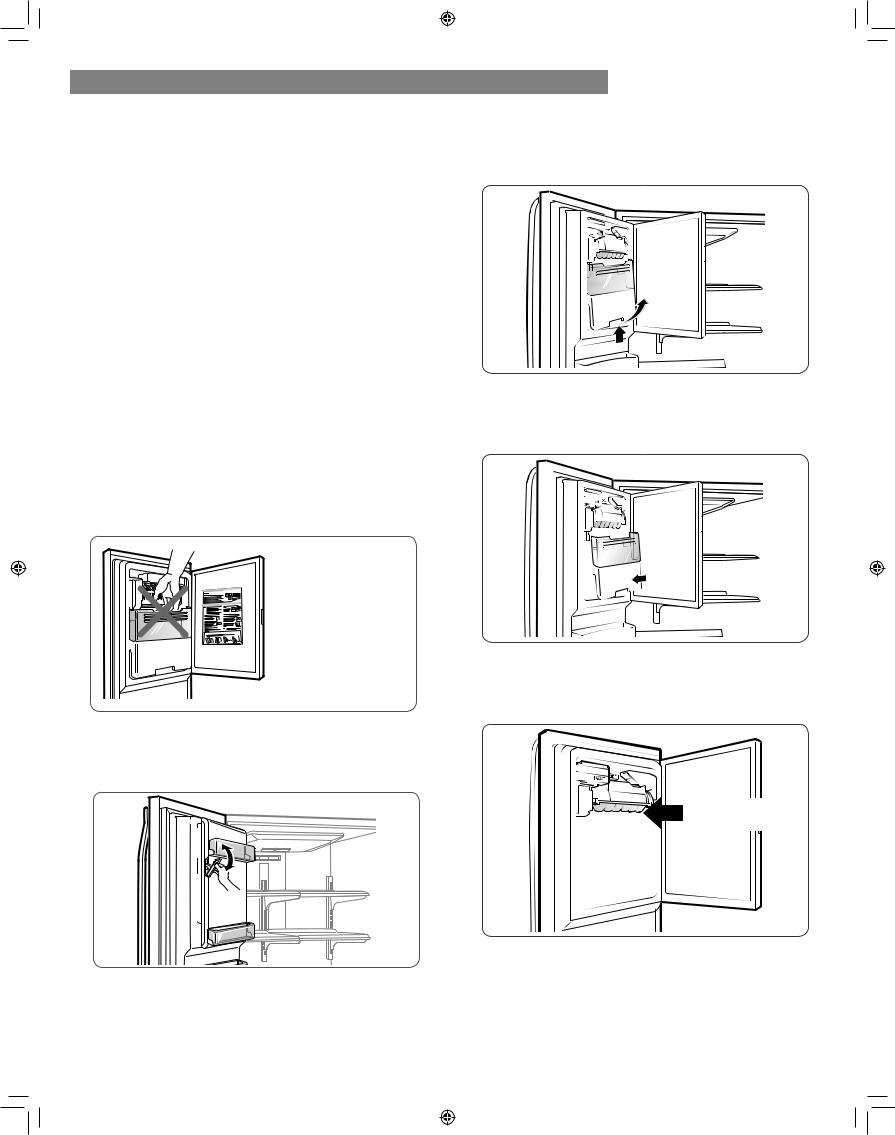
Using your Refrigerator
IN-DOOR ICE BIN  CAUTION:
CAUTION:
Keep hands and tools out of the ice compartment door and dispenser chute. Failure to do so may result in damage or personal injury.
The icemaker will stop producing ice when the in-door ice bin is full. If you need more ice, empty the ice bin into the extra ice bin in the freezer compartment. During use, the ice can become uneven causing the icemaker to misread the amount of ice cubes and stop producing ice. Shaking the ice bin to level the ice within it can reduce this problem.
NOTE: Storing cans or other items in the ice bin will damage the icemaker.
Keep the ice compartment door closed tightly. If the ice compartment door is not closed tightly, the cold air in the ice bin will freeze food in the refrigerator compartment. This could also cause the icemaker to stop producing ice.
NOTE: Emptying the ice bin is recommended if the icemaker ON/OFF button on the control panel is set to OFF for an extended period of time.
 CAUTION
CAUTION
When handling the ice bin, keep hands away from the icemaker tray area to avoid personal injury.
1.Pull or push the door handle to open or close the ice compartment.
2.To remove the in-door ice bin, grip the front handle, slightly lift the lower part, and slowly pull out the bin as shown.
3.To reinstall the in-door ice bin, slightly slant the bin during replacement to avoid contact with the icemaker.
4.Avoid touching the auto shutoff (feeler arm) when replacing the ice bin. See the label on the ice compartment door for details.
Auto shutoff
(feeler arm)
24
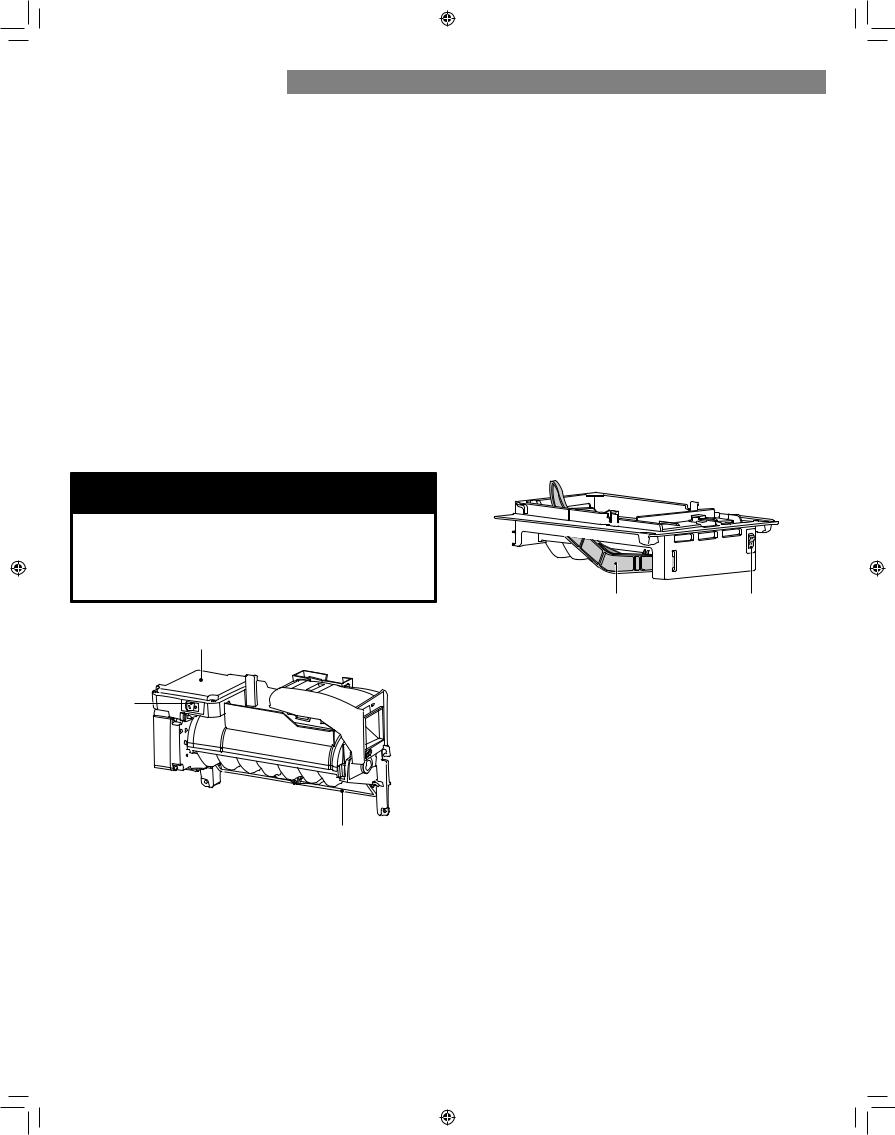
IN-DOOR ICEMAKER
Ice is made in the automatic icemaker and sent to the dispenser. The icemaker will produce 70-182 cubes in a 24-hour period, depending on freezer compartment
temperature, room temperature, number of door openings and other operating conditions.
•It takes about 12 to 24 hours for a newly installed refrigerator to begin making ice. Wait 72 hours for full ice production to occur.
•Ice making stops when the in-door ice bin is full. When full, the in-door ice bin holds approximately 6 to 8 (12-16 oz or 340-455 cc) glasses of ice.
•Foreign substances or frost on the auto shutoff (feeler arm) can interrupt ice production. Make sure the feeler arm is clean at all times for proper operation.
•To increase ice production, use the Accela Ice function. This function increases both ice making and freezing capabilities.
Using your Refrigerator
FREEZER ICEMAKER
•This automatic freezer icemaker produces 12 cubes at a time, 50-110 pieces within a 24 hour period
if conditions are favorable. This amount may vary according to the environment (ambient temperature around the appliance, frequency of the door being opened, amount of food stored in the appliance, etc.).
•If the ice bin is completely filled with ice, ice production will stop.
•Sound of ice dropping into the ice bin is normal.
•The icemaker produces ice once approximately 48 hours have passed after the appliance is initially installed.
•Discard the first ice cubes produced after initial install.
•Ice cubes which are stored in the ice bin for a long time may clump together and be difficult to separate.
If this happens, empty the ice bin completely and clean it before reinstalling it.
 WARNING
WARNING
Personal Injury Hazard
DO NOT place fingers or hands on the automatic ice making mechanism while the refrigerator is plugged in.
Feeler Arm |
Power Switch |
lcemaker
Power
Switch
Auto shutoff (feeler arm)
25

Using your Refrigerator
ICEMAKER (continued)
 CAUTION
CAUTION
•The first ice and water dispensed may include particles or odor from the water supply line or the water tank.
•Throw away the first few batches of ice. This is also necessary if the refrigerator has not been used for a long time.
•Never store beverage cans or other items in the ice bin for the purpose of rapid cooling. Doing so may damage the icemaker or the containers may burst.
•If discolored ice is dispensed, check the water filter and water supply. If the problem continues, contact a Sears or other qualified service center. Do not use the ice or water until the problem is corrected.
•Keep children away from the dispenser. Children may play with or damage the controls.
•The ice passage may become blocked with frost if only crushed ice is used. Remove the frost that accumulates by removing the ice bin and clearing the passage with a rubber spatula. Dispensing cubed ice can also help prevent frost buildup.
•Never use thin crystal glass or crockery to collect ice. Such containers may chip or break resulting in glass fragments in the ice.
•Dispense ice into a glass before filling it with water or other beverages. Splashing may occur if ice is dispensed into a glass that already contains liquid.
•Never use a glass that is exceptionally narrow or deep. Ice may jam in the ice passage and refrigerator performance may be affected.
•Keep the glass at a proper distance from the ice outlet. A glass held too close to the outlet may prevent ice from dispensing.
•To avoid personal injury, keep hands out of the ice door and passage.
•Never remove the dispenser cover.
•If ice or water dispenses unexpectedly, turn off the water supply and contact Sears Home Service at 1-844-553-6667.
WHEN YOU SHOULD SET THE ICEMAKER
ON/OFF BUTTON TO OFF
•When the water supply will be shut off for several hours.
•When the ice bin is removed for more than one or two minutes.
•When the refrigerator will not be used for several days.
NOTE: The ice bin should be emptied when the icemaker on/off button is set to the OFF mode.
NORMAL SOUNDS YOU MAY HEAR
•The icemaker water valve will buzz as the icemaker fills with water. If the power button has been set to ON, the icemaker will buzz even if it has not yet been hooked up to water. To stop the buzzing, set the ON/OFF button to OFF.
NOTE: Keeping the power turned ON to the icemakers before the water line is connected can damage the icemakers.
•You will hear the sound of cubes dropping into the bin and water running in the pipes as the icemakers refill.
PREPARING FOR VACATION
Set the button on both icemakers to OFF and shut off the water supply to the refrigerator.
NOTE: The ice bins should be emptied any time the icemaker on/off buttons are set to OFF.
If the ambient temperature will drop below freezing, have a qualified technician drain the water supply system to prevent serious property damage due to flooding caused by ruptured water lines or connections.
26

FOOD STORAGE GUIDE
Wrap or store food in the refrigerator in airtight and moisture-proof material unless otherwise noted. This prevents food odor and taste transfer throughout the refrigerator. For dated products, check date code to ensure freshness.
Items |
How to |
|
|
Butter or |
►►Keep opened butter in a covered |
margarine |
dish or closed compartment. |
|
When storing an extra supply, |
|
wrap in freezer packaging and |
|
freeze. |
|
|
Cheese |
►►Store in the original wrapping |
|
until you are ready to use it. Once |
|
opened, rewrap tightly in plastic |
|
wrap or aluminum foil. |
|
|
Milk |
►►Wipe milk cartons. For best |
|
storage, place milk on interior |
|
shelf, not on door shelf. |
|
|
Eggs |
►►Store in original carton on interior |
|
shelf, not on door shelf. |
|
|
Fruit |
►►Do not wash or hull the fruit until it |
|
is ready to be used. Sort and keep |
|
fruit in its original container, in a |
|
crisper, or store in a completely |
|
closed paper bag on a refrigerator |
|
shelf. |
|
|
Leafy |
►►Remove store wrapping and trim |
vegetables |
or tear off bruised and discolored |
|
areas. Wash in cold water and |
|
drain. Place in plastic bag or |
|
plastic container and store in |
|
crisper. |
|
|
Vegetables |
►►Place in plastic bags or plastic |
with skins |
container and store in crisper. |
(carrots, |
|
peppers) |
|
|
|
Fish |
►►Store fresh fish and shellfish in |
|
the freezer section if they are not |
|
being consumed the same day of |
|
purchase. It is recommended to |
|
consume fresh fish and shellfish the |
|
same day purchased. |
|
|
Leftovers |
►►Cover leftovers with plastic wrap |
|
or aluminum foil, or store in plastic |
|
containers with tight lids. |
|
|
Using your Refrigerator
STORING FROZEN FOOD
NOTE: Check a freezer guide or a reliable cookbook for further information about preparing food for freezing or food storage times.
Freezing
Your freezer will not quick-freeze a large quantity of food. Do not put more unfrozen food into the freezer than will freeze within 24 hours (no more than 2 to 3 lbs. of food per cubic foot of freezer space). Leave enough space in the freezer for air to circulate around packages. Be careful to leave enough room at the front so the door can close tightly.
Storage times will vary according to the quality and type of food, the type of packaging or wrap used (how airtight and moisture-proof) and the storage temperature. Ice crystals inside a sealed package are normal. This simply means that moisture in the food and air inside the package have condensed, creating ice crystals.
NOTE: Allow hot foods to cool at room temperature for 30 minutes, then package and freeze. Cooling hot foods before freezing saves energy.
Packaging
Successful freezing depends on correct packaging. When you close and seal the package, it must not allow air or moisture in or out. If it does, you could have food odor and taste transfer throughout the refrigerator and could also dry out frozen food.
Packaging recommendations:
•Rigid plastic containers with tight-fitting lids
•Straight-sided canning/freezing jars
•Heavy-duty aluminum foil
•Plastic-coated paper
•Non-permeable plastic wraps
•Specified freezer-grade self-sealing plastic bags
Follow package or container instructions for proper freezing methods.
Do not use
•Bread wrappers
•Non-polyethylene plastic containers
•Containers without tight lids
•Wax paper or wax-coated freezer wrap
•Thin, semi-permeable wrap
 CAUTION: Do not keep beverage cans or plastic food containers in the freezer compartment. They may break or burst if they freeze.
CAUTION: Do not keep beverage cans or plastic food containers in the freezer compartment. They may break or burst if they freeze.
27
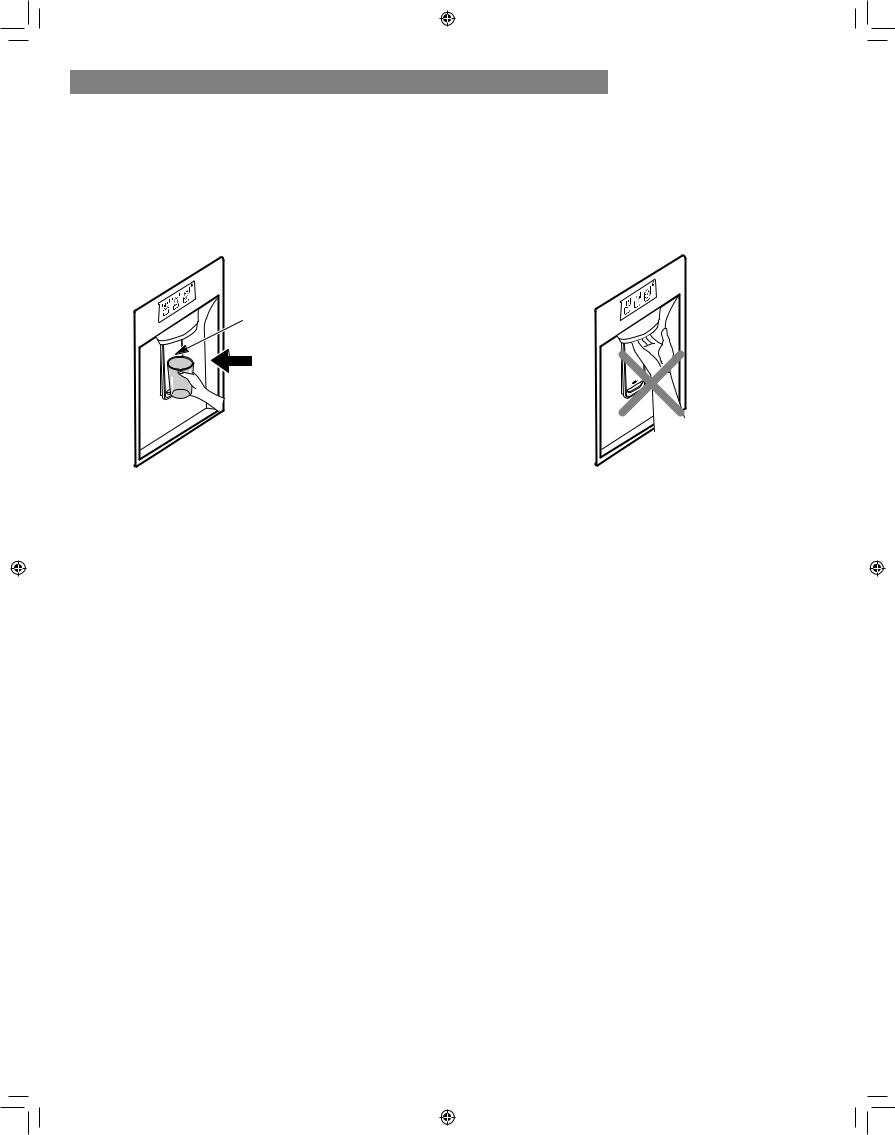
Using your Refrigerator
REFRIGERATOR SECTION
WATER DISPENSER
To dispense cold water, push on the dispenser switch with a glass.
NOTE: The dispenser is equipped with a light that turns on when the dispenser pad is engaged.
 WARNING: Do not put your fingers up the ice chute opening. Doing so can result in severe injury.
WARNING: Do not put your fingers up the ice chute opening. Doing so can result in severe injury.
 CAUTION: Do not dispense ice into fine china or crystal glasses. China or crystal can break.
CAUTION: Do not dispense ice into fine china or crystal glasses. China or crystal can break.
Dispenser Switch
Push
Some dripping may occur after dispensing. Hold your cup beneath the dispenser for a few seconds after dispensing to catch all of the drops.
28
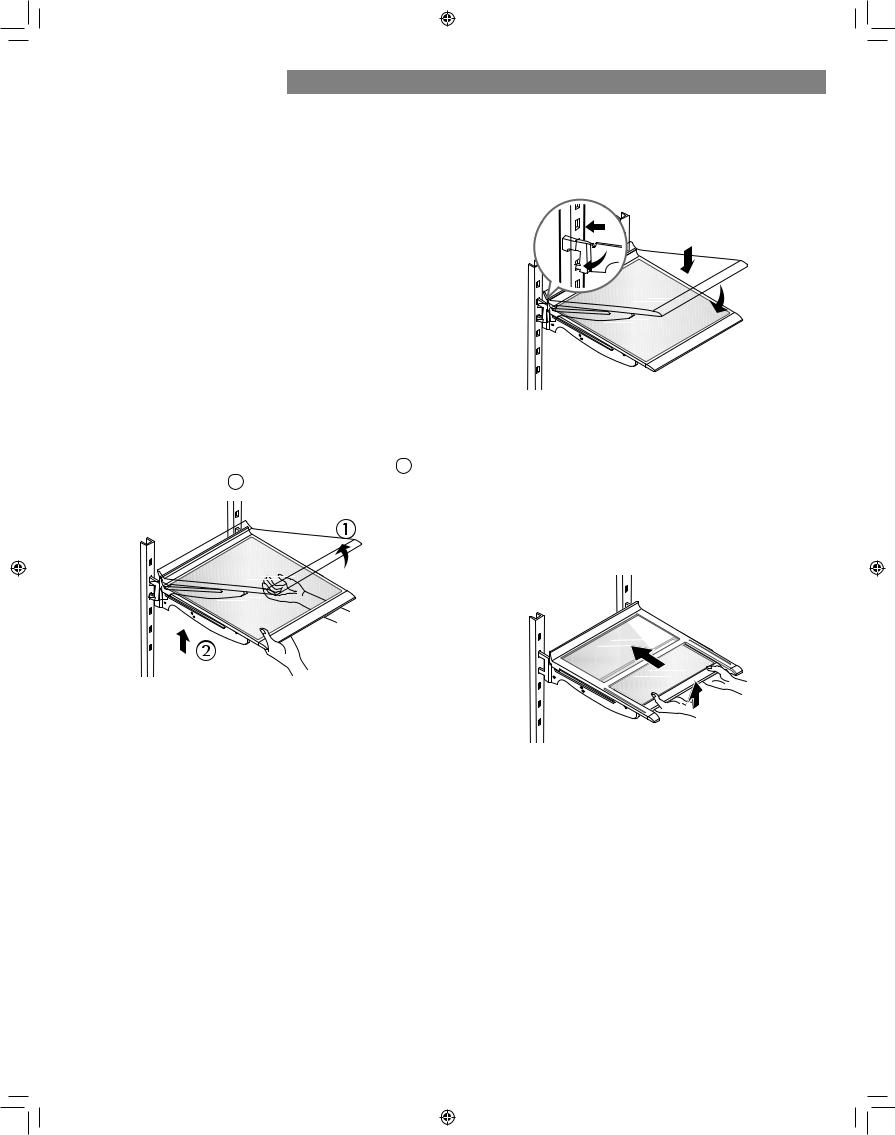
REFRIGERATOR SHELVES
The shelves in your refrigerator are adjustable to meet your individual storage needs. Your model may have glass or wire shelves.
Adjusting the shelves to fit items of different heights will make finding the exact item you want easier. Doing so will also reduce the amount of time the refrigerator door is open which will save energy.
IMPORTANT: Do not clean glass shelves with warm water while they are cold. Shelves may break if exposed to sudden temperature changes or impact.
 CAUTION: Glass shelves are heavy. Use special care when removing them.
CAUTION: Glass shelves are heavy. Use special care when removing them.
Adjusting Shelves (Cantilever)
Remove shelves from the shipping position and replace shelves in the position you want.
To remove a shelf—Tilt up the front of the shelf 1 and lift it from below 2 . Pull the shelf out.
Using your Refrigerator
To reinstall a shelf—Tilt the front of the shelf up and guide the shelf hooks into the slots at a desired height. Then, lower the front of the shelf so that the hooks drop into the slots.
 CAUTION: Make sure that shelves are level from one side to the other. Failure to do so may result in the shelf falling or spilling food.
CAUTION: Make sure that shelves are level from one side to the other. Failure to do so may result in the shelf falling or spilling food.
Folding Shelf (on some models)
You can store taller items, such as a gallon container or bottles, by simply pushing the front half of the shelf
underneath the back half of the shelf. Pull the front of the shelf toward you to return to a full shelf.
29
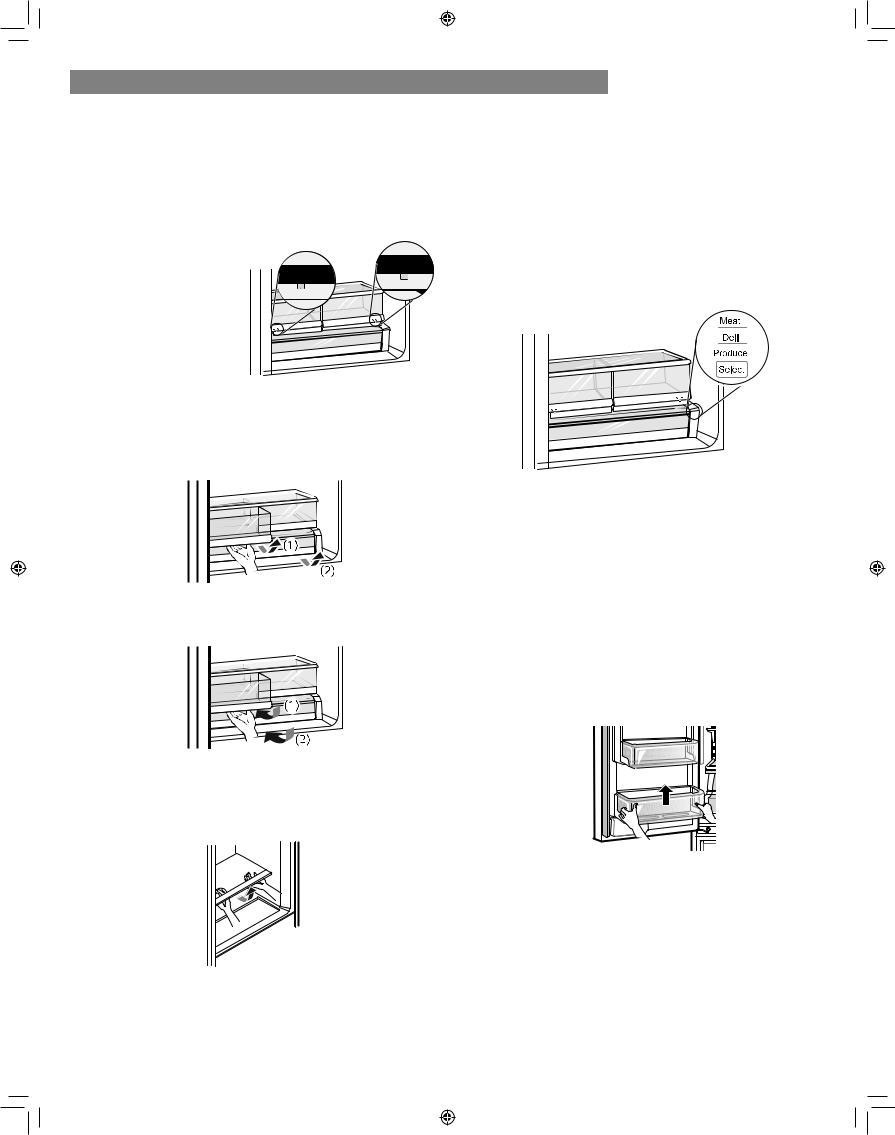
Using your Refrigerator
HUMIDITY CONTROLLED CRISPER
The crispers provide fresher tasting fruit and vegetables by letting you easily control humidity inside the drawer.
You can control the amount of humidity in the moisturesealed crispers by adjusting the control to any setting between VEGETABLES and FRUIT.
• VEGETABLES keeps moist air in the crisper for best storage of fresh, leafy vegetables.
• FRUIT lets moist air out of the crisper for best storage of fruit.
REMOVING THE HUMIDITY CONTROLLED CRISPER
1.To remove, pull out the crisper (1) or (2) to full extension, lift the front up, and pull straight out.
2.To install, slightly tilt up the front, insert the crisper or drawer into the frame and push it back into place.
Crisper Cover
To remove, lift the front of the cover up until it detaches from the back wall of the cabinet, then pull it out.
TEMPERATURE CONTROLLED PANTRY DRAWER
The Temperature Controlled Pantry Drawer provides storage space with a variable temperature control that can keep the compartment at a slightly different
temperature than the refrigerator section. This drawer can be used for large party trays, deli items and beverages. (This drawer should not be used to store vegetables that require high humidity.)
Press the Select button to choose between Produce (Cold), Deli (Colder) and Meat (Coldest).
 CAUTION: Do not store glass bottles in the pantry. If they are frozen, they can break and cause personal injury.
CAUTION: Do not store glass bottles in the pantry. If they are frozen, they can break and cause personal injury.
DOOR BIN
The door bins are removable for easy cleaning and adjustment.
1.To remove the bin, simply lift the bin up and pull straight out.
2.To replace the bin, slide it in above the desired support and push down until it snaps into place.
 CAUTION
CAUTION
•Regularly detach and wash the storage bins and shelves; the can become easily contaminated by food.
•Do not apply excessive force while detaching or assembling the storage bins.
•Do not use the dishwasher to clean the storage bins and shelves.
30
